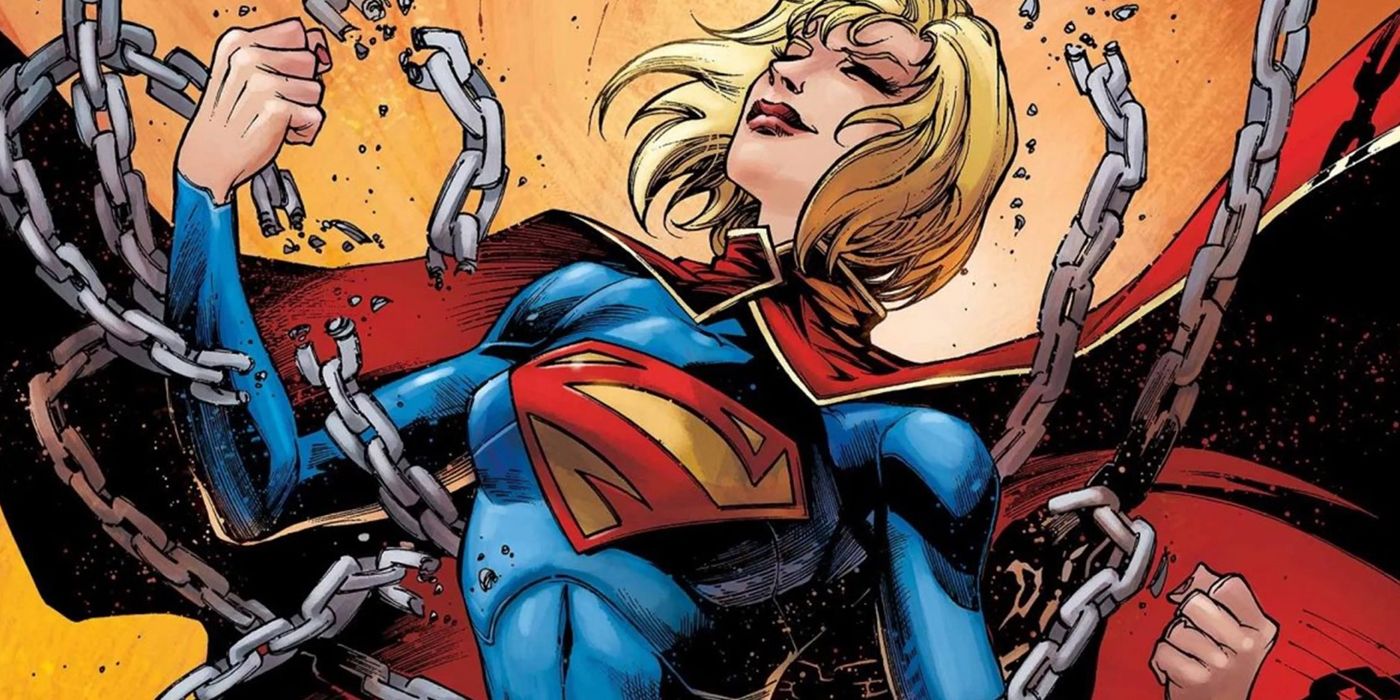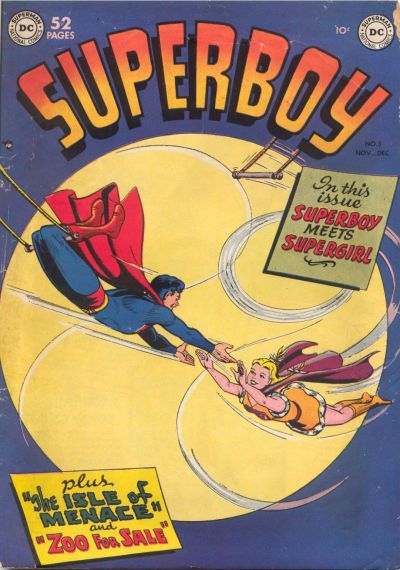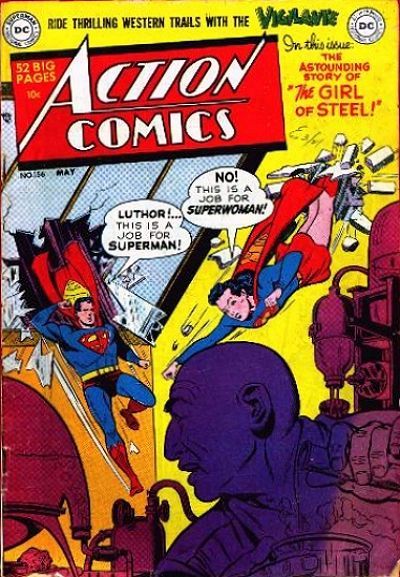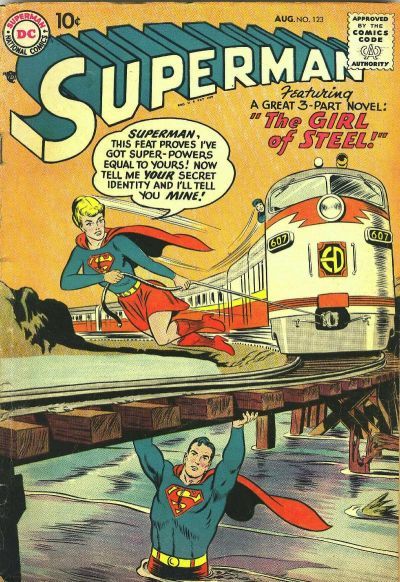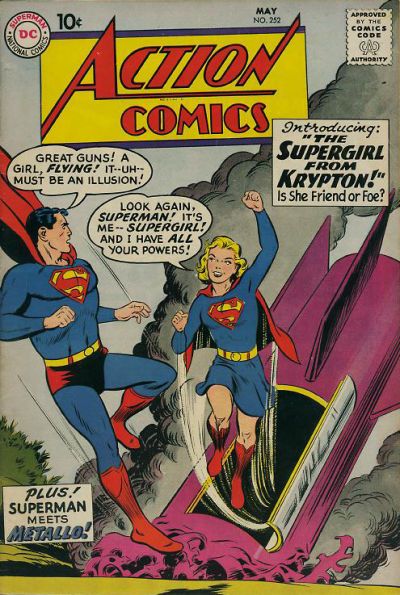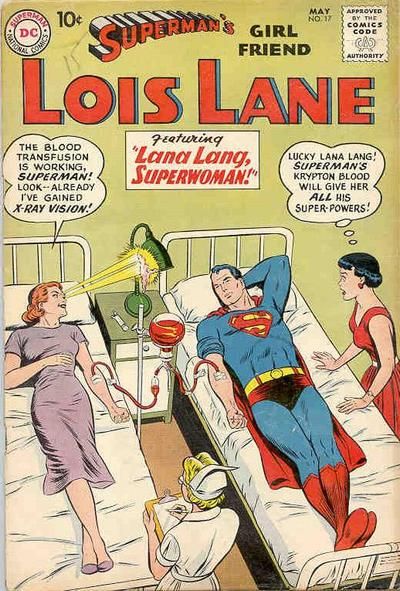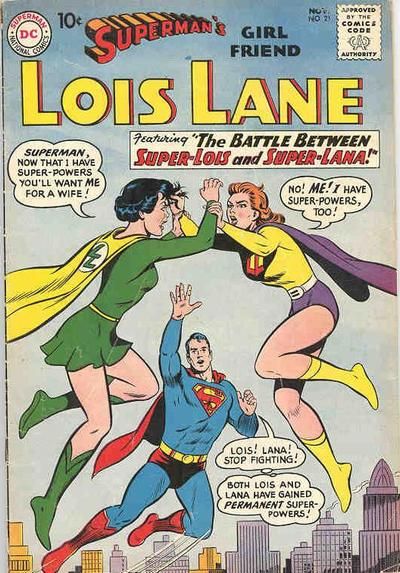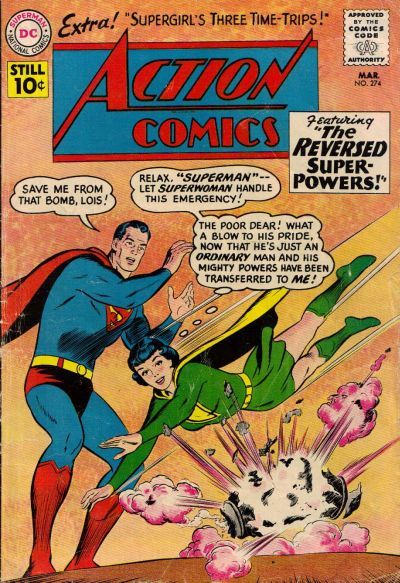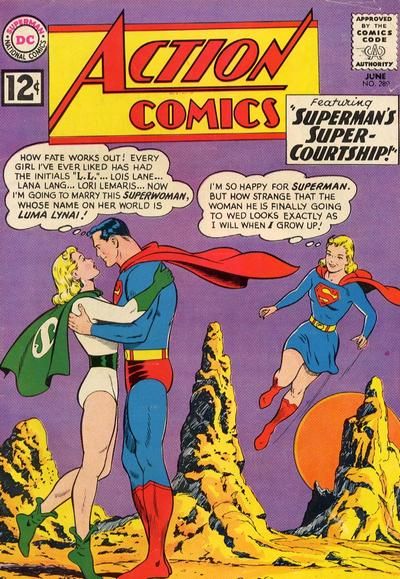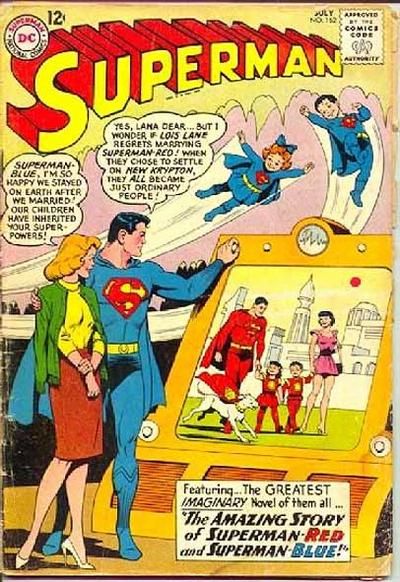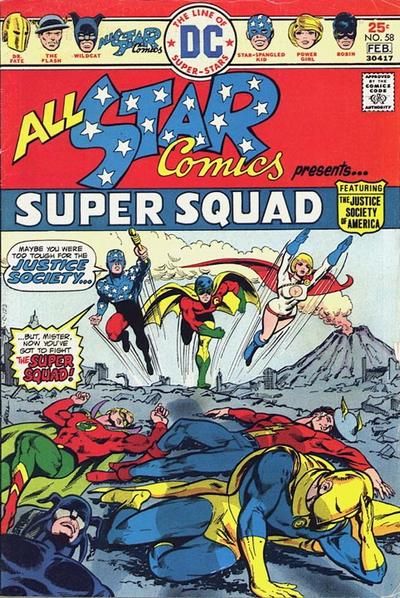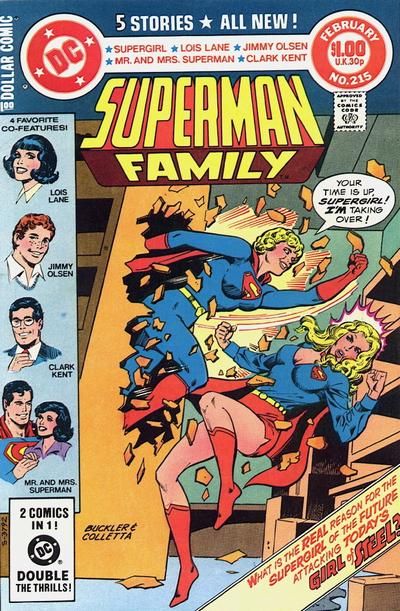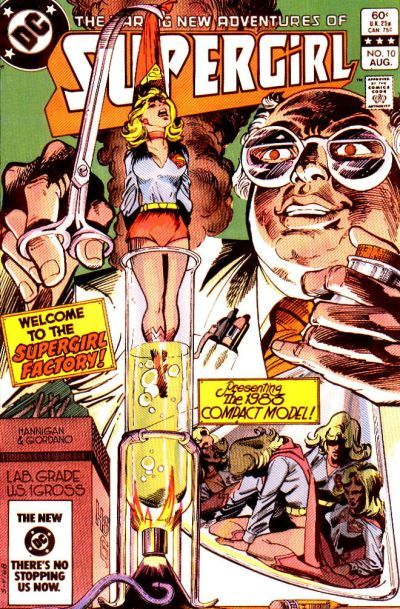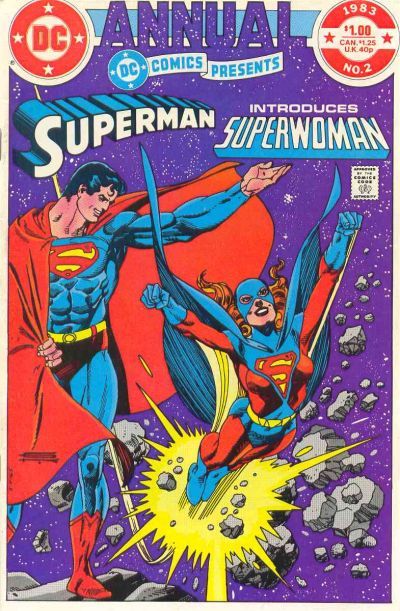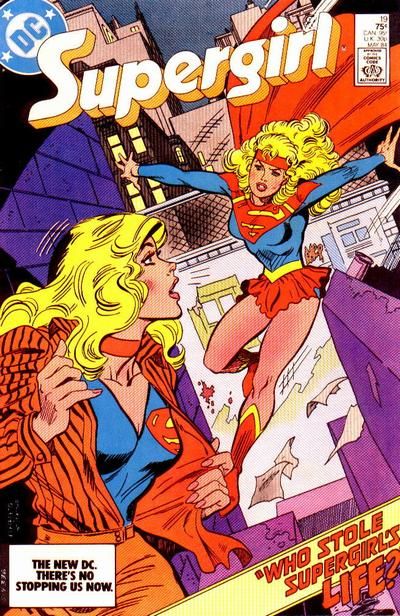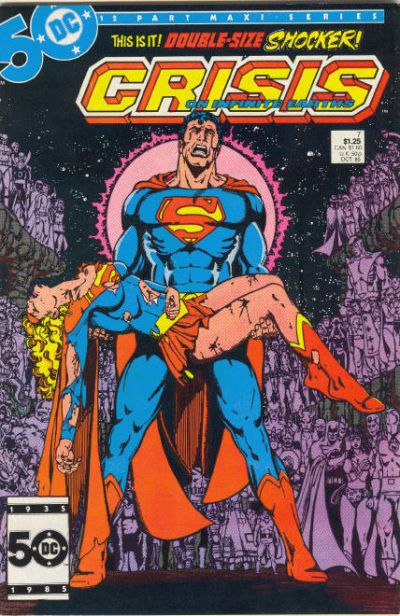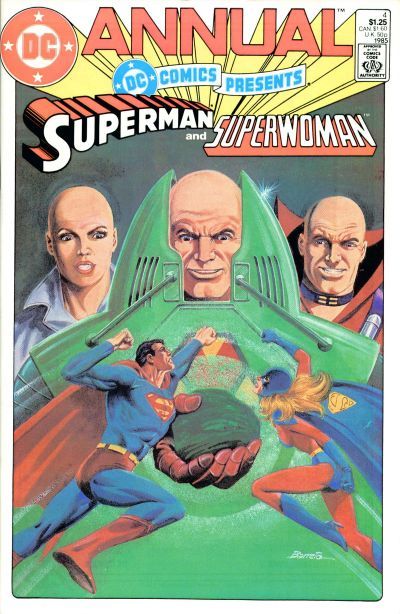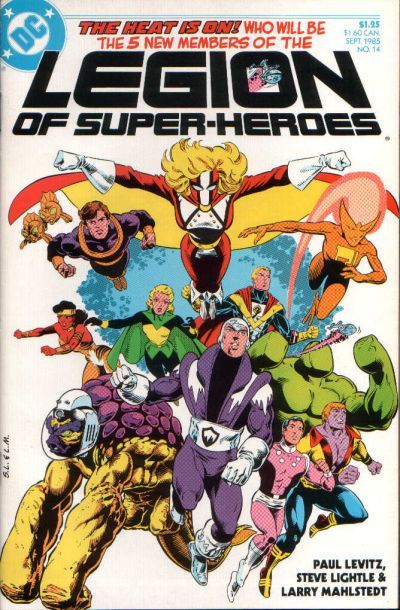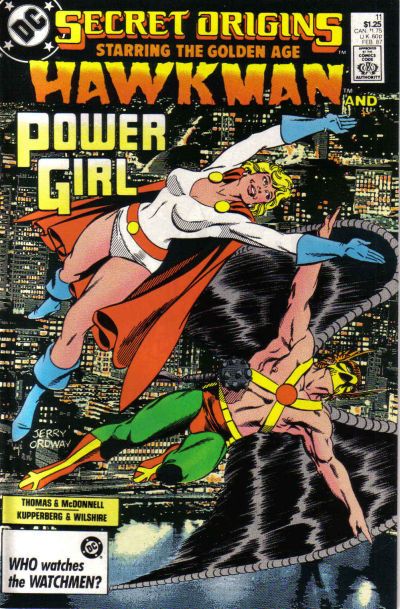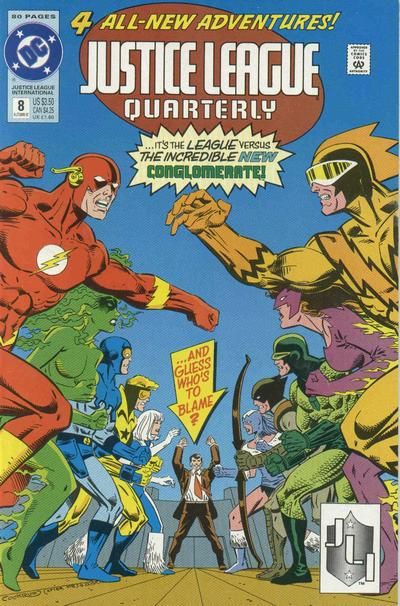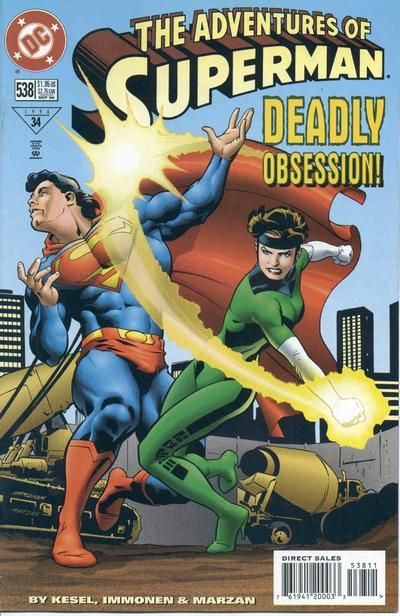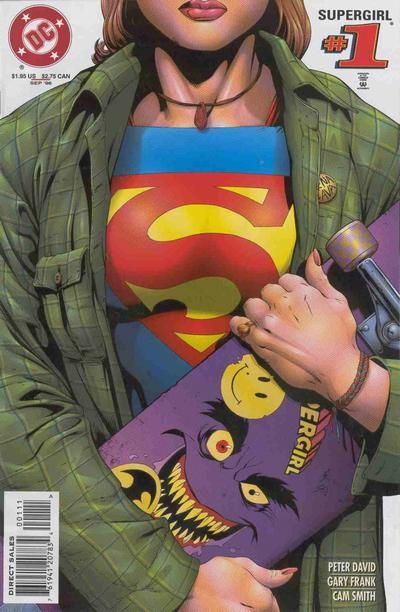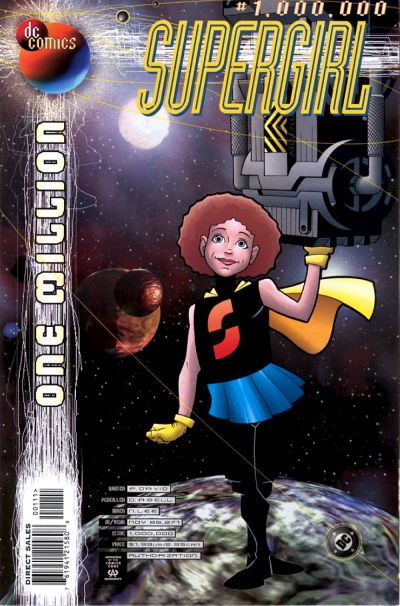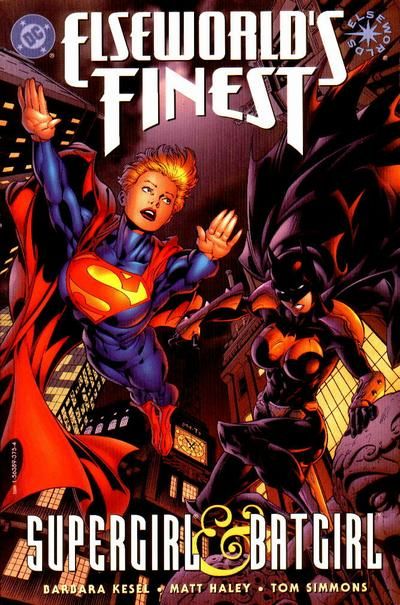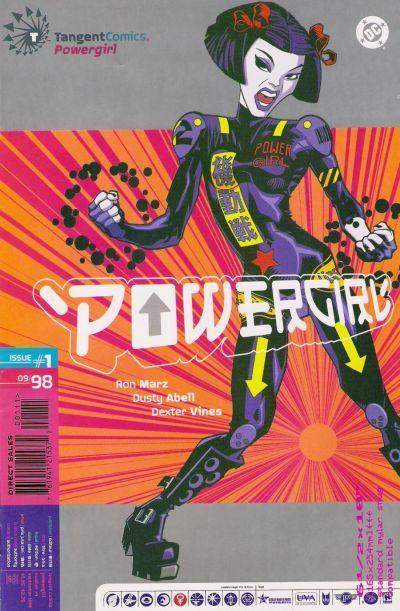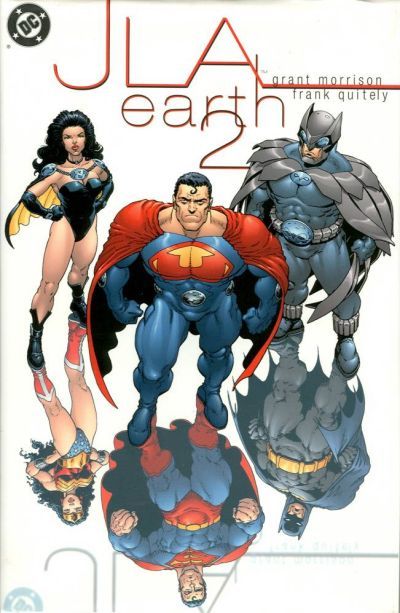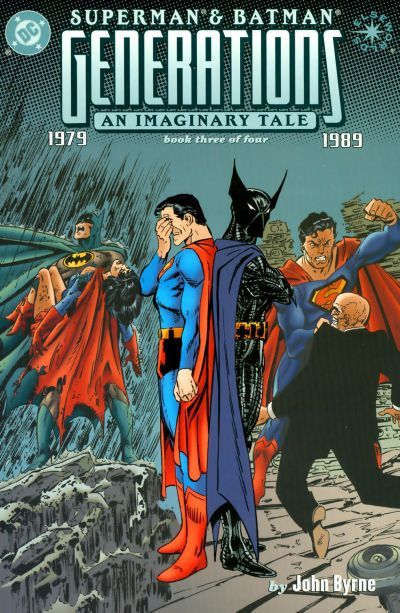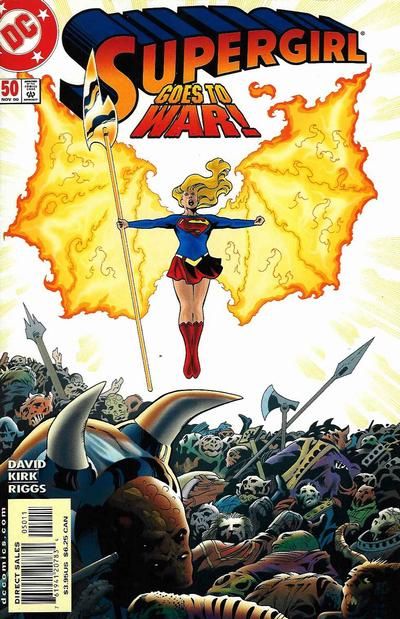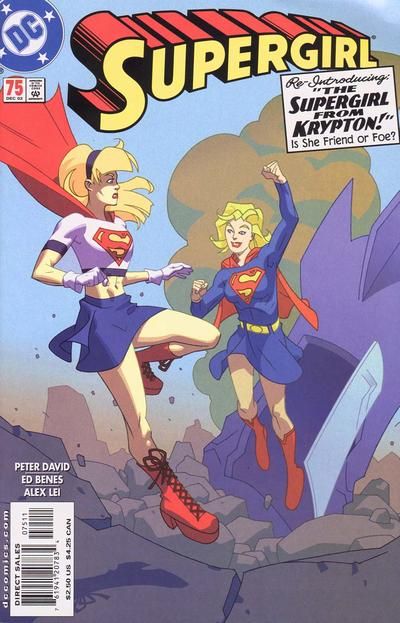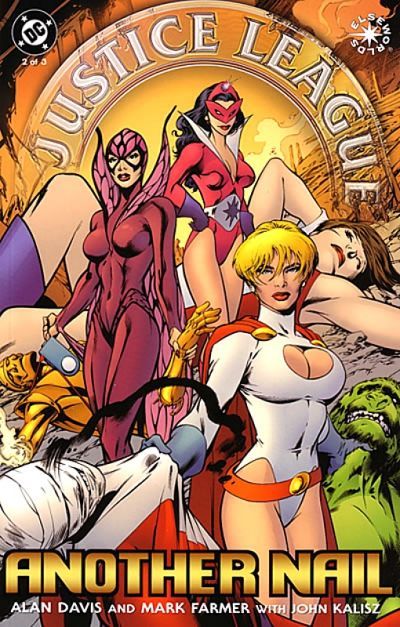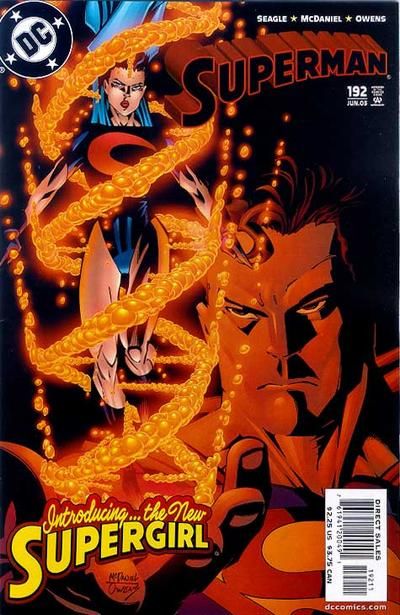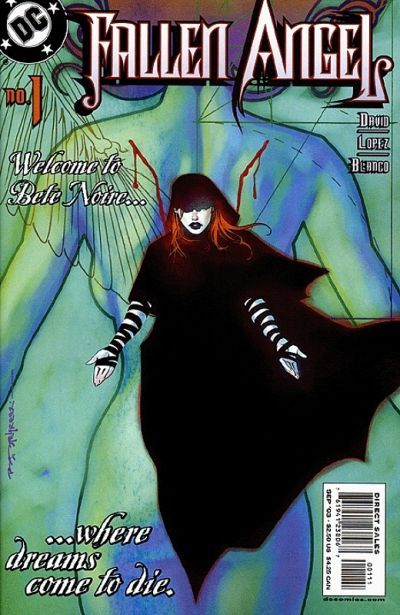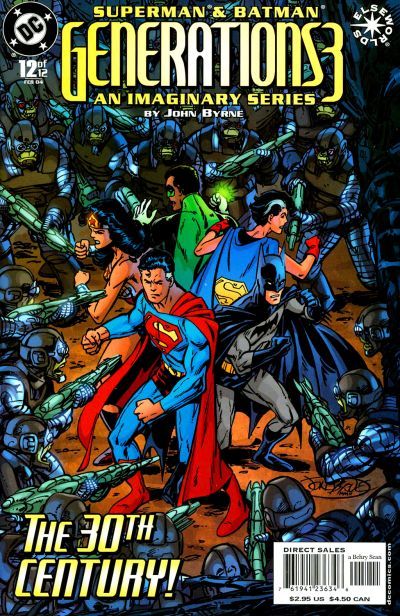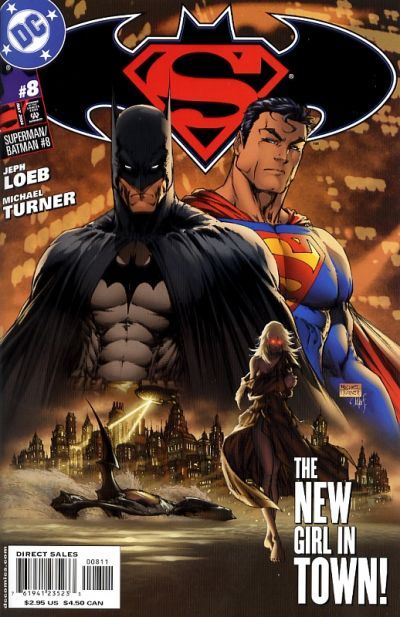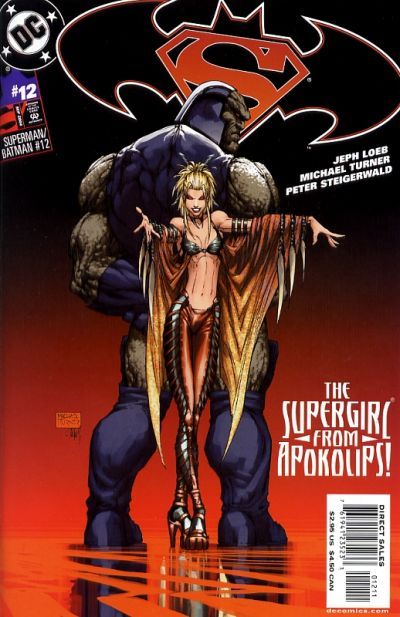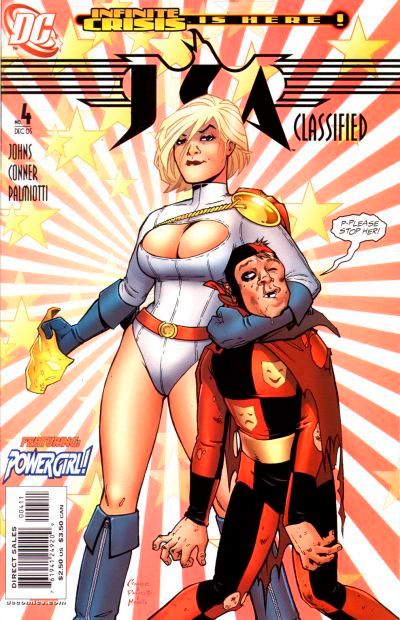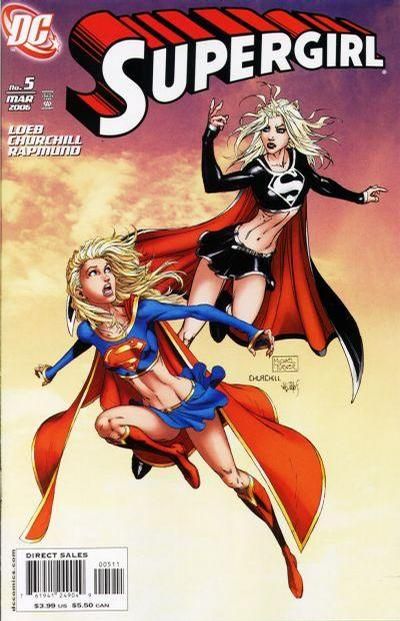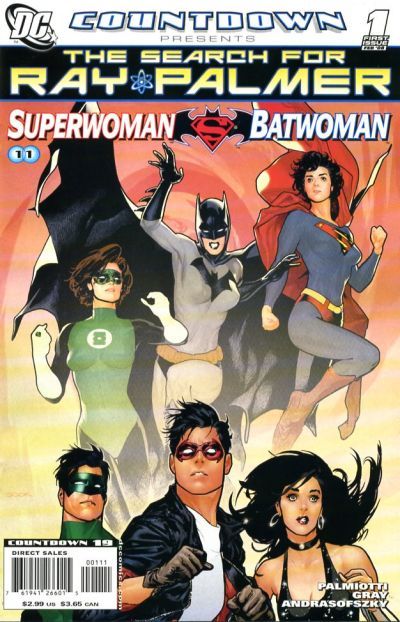Here is the archive of the lists Lorendiac posts here, and here is his latest piece!- BC.
Some of you may remember previous Drafts of this work, although it's been three years since I posted the last one. Now it's back! It is one of the longest things I have ever posted at once on any Internet forum. (Over 25,000 words.) Believe me, I will understand perfectly if you don't want to read it all in one sitting. After I had inserted all the new material, I didn't want to proofread it all in one sitting! I can scarcely expect more of you than I do of myself, right?
But as long as DC keeps dragging more Supergirls and Superwomen (and similar characters with other names) into its continuity, I will keep trying to sort them all out for you!
Table of Contents
Part One: Why I Wrote This
Part Two: Notes on Terminology
Part Three: The Timeline of First and Final Appearances
Part Four: Short Lists of the Different Users of Each Relevant Name
PART ONE: WHY I WROTE THIS
In various online forums where I hang out for comic-book-related discussions, people keep asking perfectly reasonable questions such as:
"Who is the current Supergirl? How is she different from the last Supergirl? (And the one before that, and the one before that?)"
"Just how many Supergirls have there been in the comic books, anyway?"
"Why so many?"
"Are they all related to Superman?"
The problem is that there's no simple "sound bite" of an answer that can honestly and accurately answer all those questions in one minute or less, even if you actually have all relevant facts at the tip of your tongue (which I certainly didn't when I started writing the First Draft).
For instance, if you start trying to delve into these subjects in a way that is not just shallow and superficial, but really meant to clear things up, then you've got to talk about the differences between Pre-Crisis and Post-Crisis continuity if you're going to make a clean sweep in explaining just how many Supergirls there have ever been, and why the one who held the job for over a quarter-century is no longer with us.
And since Power Girl started out as a parallel-world analog of the Silver Age Supergirl, shouldn't she at least get an honorable mention in any in-depth discussion of The Many Supergirls even though she's never claimed the name "Supergirl" in her life? What about the various females who have called themselves "Superwoman" instead of "Supergirl"? Mightn't a fan who wants to know about the Supergirls appreciate having the Superwomen sorted out for him as well, at no extra charge? What about Kara of Argo City in the Superman Versus Aliens miniseries in 1996, who never called herself "Supergirl" but was obviously designed to strongly remind us of the Pre-Crisis Supergirl who was also a Kara from Argo City, even if it was a different city and a different planet?
You see how quickly such things can escalate?
In April of 2005 I started typing out a piece explaining, from memory, what I thought I already knew about the various Supergirls, Superwomen, etc., Pre- and Post-Crisis. The early version was sadly incomplete -- I knew I didn't know everything -- but it was only a rough draft. I had a vague idea that eventually I might end up with a more "comprehensive" discussion of the subject, and after I had written and posted it, in the future I could simply post a hyperlink to it whenever newcomers on my favorite comic book forums started asking such questions as I listed above.
In early June of 2005 I got involved in an online discussion that somehow prompted me to dig out the old material on my hard drive and start sprucing it up, researching the subject further, splicing in new material, and organizing things into a comprehensive timeline showing the chronological sequence of First Appearances of each relevant character. In several cases, I mention Final Appearances as well, if there was an obvious "Final Appearance" for a particular person.
Who is a relevant character?
I've had to keep revising my own answer to that question as I go along. I've added several new names to this Draft. As it now stands, I'm interested in tracking the histories of any character who has ever been connected with Superman continuity while calling herself (and/or having other people call her) at least one of a select list of interesting names. This includes characters whose First Appearances were not "canonical" when first published, but who were later dragged into a closer relationship with some version of continuity. For instance, in 2006 many old Imaginary Stories and Elseworlds stories were retroactively assigned numbers in the Old Multiverse of the Pre-Crisis Era, and since then, other stories have been retconned as having occurred in certain worlds of the New Multiverse!
As it now stands, canonical users of the following names are included here:
Bizarro-Supergirl
Kara
Overgirl
Power Girl
Power Woman
Powergirl
Supergirl
Super-Girl
Supergirl Robot (but I only list the first one's debut)
Supergirl-Blue
Supergirl-Red
Supergrrrl
Super-Lana
Super-Lois
Superwoman
Ultragirl
Obviously, some characters fall into more than one of those categories. And, out of the goodness of my heart, I've even thrown in a few characters who didn't quite fit any of the above categories. A couple of those extras were strongly suspected by the readers to be mysterious versions of one "Supergirl" character or another. You'll see what I mean as we go along.
I should mention that for my purposes I am ignoring people who strike me as mere "temporary impostors." If there was once a story in which an ordinary human actress played the role of "Supergirl" in a TV show or movie, or a Silver Age story in which Lex Luthor built a robot double to impersonate Supergirl for a few hours (and I don't know if that ever happened!), then I'm not counting it. The Supergirl Robot that Brainiac 5 built in Superboy #204 has been brought to my attention, but for the moment I'm leaving her out of the Timeline as well. I do mention, below, the first appearance of the very first Supergirl Robot of the Silver Age, and I figure that will have to do. (When you've seen one robot double, you've seen 'em all!)
On a similar note: At this time, I have no intention of going into the details of any variation of "Supergirl" or any similar character who has only been presented to us in movies or television shows. Likewise, I am ignoring anybody who has appeared in a comic book story that was not meant to be, and never retroactively became, "connected" to the mainstream DCU continuity, Pre- or Post-Crisis, in any clear way. My rule of thumb is that if a world was stated to be part of the Old Multiverse, or part of the New Multiverse, or it has been demonstrated that characters can travel back and forth from that world to other worlds/timelines/whatever which are definitely "canonical," then any stories set on that world are fair game. But if the story was specifically labeled "an Imaginary Story," or an Elseworlds, or otherwise was flagrantly "out of continuity," and no retcon was ever made to tie that story’s world more closely to the rest of the DCU of one era or another, then I’m not interested in it.
As one example: These rules exclude Kara In-Ze, the Supergirl of the DCAU (DC Animated Universe). She has appeared in a few comic books set in that same universe, but none of those stories were ever "connected" with DC's mainstream continuity in the sense of characters being able to jump back and forth between Kara In-Ze’s native timeline and other timelines featured in conventional DC comic books. Anticipating a possible objection: I know that Earth-12 of the New Multiverse has been stated to have a Batman named Terry McGinnis. This was the name of the hero of the Batman Beyond TV series, happening decades after the main events of other DCAU series about Batman, Superman, etc. But to the best of my knowledge, we have not been assured that all episodes of all DCAU shows have, in fact, occurred in Earth-12's history. Since there is no solid reason to believe that Kara In-Ze ever existed in Earth-12, she doesn't count as canonical in this Timeline!
(But if her situation changes, she may someday qualify as "canonical" in a later Draft! Anything's possible!)
Note: As I type this paragraph (January 2010), DC is publishing a new miniseries about the latest version of Superman's origin story -- how he became the man he is today in what DC currently calls its "modern continuity." I have not been reading that mini, and it isn't over yet. I will probably buy a TPB collection someday. Right now I don't know what sort of ripple effects that mini will have on the previously established continuity of any of the Supergirls (and Superwomen, and other names) on my list. So I decided to not even worry about it. But if you see something in here which is already becoming obsolete thanks to a recent retcon, please let me know!
PART TWO: NOTES ON TERMINOLOGY
Since the posting of my Fourth Draft (three years ago this month), various things have happened in DC's continuity which create new opportunities for confusion in a discussion of all the Supergirls, Superwomen, etc., who have ever been "in continuity," Pre- or Post-Crisis. For instance, DC now has a second Multiverse replacing its officially-long-defunct first one, so if I just casually refer to "the Multiverse," alert readers will promptly wonder which one I'm talking about! Likewise, both Multiverses have had worlds with names pronounced "Earth-One," "Earth-Two," and "Earth-Three."
I had to decide how to distinguish between different things which have carried the same names at different times in DC's comic books. Here are the definitions which I am using in the actual Timeline.
Old Multiverse. The endless quantity of parallel universes which were used as plot devices in many of DC's Silver Age and Bronze Age stories. Most of those were destroyed in 1985, in the course of the notorious "Crisis on Infinite Earths." I have to call that entire concept something, and "Old Multiverse" seems simple and straightforward.
New Multiverse. The new set of 52 parallel universes which was recently established to exist in DC's modern continuity when 52 #52 came out in 2007. These parallel universes were supposedly created during the events of the Infinite Crisis miniseries, but that little detail was not shared with the fans until a year after the fact! Since we have only known about the existence of those parallel Earths for less than three years as I write this (January 2010), I figure "New Multiverse" is a good label for the entire set.
Timeline or timeline. If I say "the Timeline" with a capital T, I am referring to this document (and/or previous drafts thereof). If I mention a "timeline" with a small T, I am referring to one of the many fictional universes (also known as "alternate timelines," "parallel universes," etc.) which people at DC have created at one time or another in the course of several decades of storytelling.
COIE. This is an abbreviation for "Crisis On Infinite Earths." It refers to the 12-part series of that title; it also refers to the events depicted in that series, and more broadly to the associated fallout from those events (such as a mixture of reboots and smaller retcons) which impacted other DC titles in the mid-to-late 1980s after the 12-part series had come and gone.
Pre-Crisis and Post-Crisis. In the past, I've sometimes used Pre-COIE and Post-COIE as adjectives, but I finally decided it wasn't worth the trouble. Not in this document, anyway. For one thing, if you want to read a bit of this aloud to someone in order to explain something about a certain character, it's probably easier for you to say "Pre-Crisis" than it is to sound out an abbreviation as "Pre-Cee Oh Eye Ee."
Accordingly, "Pre-Crisis" will refer to just about any story DC ever published before or during the Crisis on Infinite Earths (and some which were published after the miniseries ended). "Pre-Crisis" also refers to the various parallel worlds which existed as part of the Old Multiverse, even though in many cases we readers only learned about those worlds, and their numerical designations in the Old Multiverse, long after COIE had ended and those parallel worlds had presumably been destroyed!
"Post-Crisis" refers to almost anything published after COIE ended, unless we've been specifically told it filled a slot in Pre-Crisis continuity. (As when certain Elseworlds projects have retroactively been declared to be part of the Old Multiverse.)
Earth-One, Earth-1, Earth-Two, Earth-2, etc. The parallel universe which was the default setting for most of DC's published stories in the Silver and Bronze Ages was sometimes called "Earth-One" in lettered dialogue and sometimes "Earth-1." The same applied to the "Earth-Two" and "Earth-Three" of the Old Multiverse.
A Wikipedia page listing all the known Earths of both Multiverses uses a convention of spelling out the numerical word as part of an Earth's name if it was a low-numbered Earth of the Old Multiverse, but just giving the actual numerals after "Earth-" when mentioning the name of any Earth of the New Multiverse. I decided that approach made sense; at least for any Old Multiverse Earth whose number was a single digit. So if I say "Earth-Three" later in this Timeline, I'm always talking Old Multiverse; but if I say "Earth-3," I'm always talking New Multiverse, okay? (Most of the time I will try to specify which Multiverse the Earth was in.)
Note: One tricky point is that such terms as "Earth-One" can be used very broadly, to describe not just the planet Earth as it existed in DC's Silver Age and Bronze Age publications, and not just the residents of that planet, but also all the other people, places, and things which existed elsewhere in the same universe. The same applies to the names of the other Earths. Just because someone is an "Earth-One" character doesn't mean he or she ever set foot on that planet at all!
First Appearance. Most of the time I apply this phrase to a character's first published comic book appearance. But that requires that the character, in that story, either claim the name "Kara" or else be using one of the other names on my approved list ("Supergirl" and "Superwoman" are the most popular). Sometimes a female character did not apply such a name to herself until long after she debuted under another name. For instance: I don't list the First Appearance of Earth-Two's Lois Lane as a civilian journalist, but I do list her "First Appearances" in various costumed capacities later on!
If a character gets rebooted, all or nearly all of her previous stories thrown out the window, I usually count this as the debut of a new character. (The Kara Zor-El who has her own title right now is not the same person as the late, lamented Kara Zor-El of the Silver and Bronze Ages.)
Final Appearance. My thinking on the proper use of this term has fluctuated over the years. If a character dies in a certain story (and stays dead), or abandons her colorful costumed role (and this actually sticks), then that's a Final Appearance for that character, at least in that identity.
For instance: In Supergirl #80, the last issue of her monthly title, Linda Danvers (Post-Crisis version) wrote a lengthy letter to Superman in which she explained why she was now abandoning the role of "Supergirl" forever. Linda has appeared in a few other stories since then, but has never changed her mind about being Supergirl. So I still feel comfortable calling Supergirl #80 the Final Appearance of a Supergirl identity.
Sometimes, after what I call a "Final Appearance," another story is published which tells us something new about an adventure the character once had in her Supergirl role (or some other role). Flashbacks and time travel have both been used as excuses. In such cases, I am still inclined to call the old story of her death or retirement the "Final Appearance," since from the character's own point of view, the new story happened before the story in which she died or quit!
Harking back to the example of Linda Danvers (Post-Crisis): Well after she had abandoned the Supergirl role, she reappeared in her old costume in Superman/Batman #25. But nobody in the story said she had chosen to come out of retirement for the occasion, so -- considering circumstances I won't rehash here -- I concluded that the Linda we were seeing had been magically yanked out of a previous moment in her life, one which occurred well before the events which would later cause her to quit. Thus I don't think that Superman/Batman story counts as a second "Final Appearance" for her Supergirl identity. (The same general reasoning applies to a couple of other Supergirl characters appearing in that same story, both of whom had previously died and then been erased from history for good measure!)
What about cases where a character got one or two appearances and then just faded away into comic book limbo, never to be seen again? (Or perhaps just briefly referred to in a few later stories, but not getting to do anything?) In the past, I have been inclined to call such a character's last published adventure the "Final Appearance." But I've reconsidered. If the character appeared to still be using a certain costumed role when last heard from, I'll probably just mention that she's never done much of anything since then, but I won't use the very dramatic label of "Final Appearance."
PART THREE: THE TIMELINE OF FIRST AND FINAL APPEARANCES
Caveat Lector (Let the Reader Beware): This is only a Fifth Draft of the Timeline, and may not be the final word on the subject. At this point in my First Draft, I said: "I have done the best I could, but I feel certain I have not done it perfectly. Please speak up if you know of a relevant fact or character I completely overlooked, or if you spot a clear mistake in my quick description of a particular character or story. In many cases I am dependent upon online summaries of stories I have never read, and I am painfully aware that my efforts to paraphrase second-hand information leave plenty of room for error."
That request has remained in every subsequent draft, and I am happy to say that many readers have taken me at my word and have offered constructive criticism on how to make future drafts superior. I may not always agree with the suggestions I receive, but I often do, and I always appreciate the trouble my fellow fans have taken in trying to help me fine-tune this project! I make no promises about how quickly your feedback will be reflected in a Sixth Draft, however. This version is being posted three years after the Fourth!
And now, on to the actual Timeline!
March/April, 1947. Superman #45. "Lois Lane, Superwoman!" Written by Alvin Schwartz.
This story is presumably set on Earth-Two of the Old Multiverse, but it (like many old Superman and Batman stories of the Golden Age) may have also happened years later, on Earth-One.
Lois Lane is convinced she has gained powers comparable to Superman's by magic. (She hasn't. Superman is moving at super-speed to do her stunts and make it seem that way. Long story.) By the end of the story she voluntarily relinquishes the powers she thinks she has because they seem to be out of control and are thus hurting her social life with men who are afraid to get too close to her. But until then, she has indeed called herself "Superwoman" and worn an appropriate costume.
Note: There was a previous "dream sequence" story in 1943 in which Lois dreamed she got a blood transfusion from the Man of Steel and became a Superwoman, but since it was clearly labelled as a dream, that "Superwoman" appearance was basically "out of continuity." This story, on the other hand, was apparently the first "in continuity" story in which any female character wore a costume and publicly called herself Superwoman. So I count this as the First Appearance "in continuity" of a Superwoman, even if the "powers" were fake.
November/December, 1949. Superboy #5. "Superboy Meets Supergirl!" Possibly written by William Woolfolk. Collected in the TPB "Superman in the Forties."
Superboy meets this really neat blond girl who calls herself Lucy Regent and is an incredibly skilled athlete. Although she has no powers, at one point she wears a costume with a similar S-shield on the chest and calls herself "Supergirl" as part of a show the two of them put on together at a festival. Superboy is quite smitten by her, it seems, but unfortunately it turns out that she is the rightful Queen of Borgonia and duty calls. The story ends with Lucy staying in her native land to take up her duties as Queen after a villainous usurper has been defeated with Superboy's help. (Lucy was never been heard from again in any other story.)
Note: I have learned from feedback that this story must have happened on Earth-One of the Old Multiverse (even though Earth-One as a concept would not be mentioned in any comic book until the story "Flash of Two Worlds" in 1961). In the Pre-Crisis era, it was eventually decided at DC that all previously published Superboy stories were Earth-One material by default. The Earth-Two Superman had reached maturity before creating a costumed identity and surprising everyone with his superpowered feats (as shown in Action Comics #1).
May, 1951. Action Comics #156. "The Girl of Steel." Reprinted in the 1987 TPB "The Greatest Superman stories Ever Told."
Again, this story was presumably happening on Earth-Two of the Old Multiverse, but it's possible that the same events were later repeated on Earth-One.
Lois Lane temporarily receives powers which prompt her to create a Superwoman costume for herself (again!). What she comes up with is very similar to one that Kara Zor-El later wore as Supergirl. Lois even wears a blond wig to disguise her hair color -- going for a secret identity, apparently, which she had not bothered with in her previous "Superwoman" adventure (March/April, 1947). This was apparently the First Appearance of any costumed female calling herself Superwoman, and wearing an appropriate costume "in continuity," and actually having superpowers to go with the costume.
August, 1958. Superman #123. "The Three Magic Wishes: The Girl of Steel (Part 1)." Written by Otto Binder. Reprinted in black-and-white in the TPB "Showcase Presents Superman, Volume 1," and also in the TPB "Showcase Presents Supergirl, Volume 1."
This one presumably happened on Earth-One, Old Multiverse. It was allegedly a "trial balloon story" to test the market for a "Supergirl" character.
Jimmy Olsen uses magic to wish a "Super-Girl" into existence, but it doesn't work out so well and he finally wishes her back into oblivion (apparently to "save her life" after potentially lethal exposure to Kryptonite), and she's been gone ever since. Super-Girl appeared to be a blond teenager and wore a blue and red costume, modeled on Superman's, and quite similar to one of the variations which the Earth-One Supergirl would later wear.
Note: I am told that for many years afterward, whenever this story was subsequently reprinted in other comics, the color scheme of the magically-created Super-Girl's appearance was modified. Her blue-and-red costume became orange-and-green, and her blond hair became red, quite similar to that of Jimmy Olsen. Presumably this was done to accentuate the fact that she was a different person who should not be identified with the first Kara Zor-El Supergirl. (I've also read that more "modern" reprints have preserved the original red-and-blue-costume-with-blond-hair color scheme. But I can't swear to that; the only reprint I've seen is the black-and-white version.)
Second Note: I've recently learned that this was not the first story to call a female character "Super-Girl" in the title. In Adventure Comics #167 (1951) there was a story set during Superboy's years in Smallville. It was titled: "Lana Lang, Super-Girl." But as near as I can tell from online reference materials and a scanned page I saw, Lana Lang did not call herself "Super-Girl" and did not wear a red and blue costume in that story, although she did spend some time mistakenly thinking she had gained superpowers, courtesy of a "magic helmet." Apparently the cover illustration and cover text seemed to promise that she would be a brightly costumed "Super-Girl," but the actual story failed to deliver all of that!
May, 1959. Action Comics #252. "The Supergirl from Krypton!" Written by Otto Binder. Reprinted in the TPB "Superman in the Fifties." Reprinted in black-and-white in the TPB "Showcase Presents Superman, Volume 1," and also in the TPB "Showcase Presents Supergirl, Volume 1."
First Appearance of Kara Zor-El, the Supergirl of Earth-One, Old Multiverse.
This character is still fondly remembered by such nicknames as "The First Supergirl," "The Original Supergirl," "The Silver Age Supergirl," "The Classic Supergirl," "The Real Supergirl," "The Real Kara Zor-El," and so on and so forth. (Some of those nicknames for her totally overlook the story about Lucy Regent in 1949, but nobody seems to mind. Possibly because Lucy never expressed the slightest intention of becoming a regular crimefighter, anyway; her costume was just Show Biz!)
Kara Zor-El is rocketed to Earth from Argo City (a Kryptonian city which miraculously survived the explosion of the planet but has now perished anyway). When Superman first meets her, Kara is already wearing a blue-and-red costume modeled on his own, except that instead of blue shirt and blue tights, she basically wears a blue dress. Over the next 26 years or so she will change her exact look from time to time, but always maintaining a strong resemblance to Superman's traditional outfit.
Kara wants to call herself Supergirl. She is a blue-eyed blond; Superman's cute little cousin he never knew he had. (Her father was Zor-El, the brother of Superman's daddy Jor-El.) Superman ends up helping her create a secret identity as "Linda Lee," a brown-haired girl (when wearing a wig, or later using other means to alter her hair color) who was recently orphaned in a natural disaster. Using that story, he checks her into an orphanage. Much later, her "secret identity" name will change to Linda Lee Danvers (or just "Linda Danvers" for short) after she is adopted by Mr. and Mrs. Fred Danvers.
Note: Various Pre-Crisis stories, sometimes via dialogue spoken "in continuity" and sometimes in events depicted in "Imaginary Stories," established that Superman fully expected that someday Supergirl would change her alias to Superwoman when she felt the time was right, just as he had previously made the transition from Superboy to Superman at his own pace. This never actually happened as a permanent change "in continuity," however -- it was merely anticipated. Below, I will list one case where Kara was referred to as "Superwoman" very briefly, for the first time "in continuity," with no lasting impact. (There may have been other cases after that one, but I don't know anything about them.)
September, 1959. Action Comics #256. "The Great Supergirl Mirage!" Written by Otto Binder. Reprinted in black-and-white in the TPB "Showcase Presents Supergirl, Volume 1."
First appearance of a lifelike Supergirl Robot. (In the Old Multiverse's Earth-One, of course.) It becomes important to have such a robot after a fellow orphan at the Midvale Orphanage named Dick Wilson (later known as "Dick Malverne" after he was adopted) captures a "Supergirl" on film and even suspects a connection with Linda Lee.
In the early years of Kara Zor-El's activities as his helper, Superman's firm policy was to keep her existence a secret from the general public. In this instance, he manages that trick by hastily creating a Supergirl Robot to give Linda an alibi, and then to publicly reveal itself as a robotic device, in order to "disprove" that any flesh-and-blood "Supergirl" exists at all! Since the robot wears the same costume and answers to the name of Supergirl, with the real Supergirl's knowledge and consent, I figure it deserves a quick entry on this Timeline.
Note: I have no idea how many robot doubles of Supergirl, and/or of her secret identity, the Earth-One Superman ended up manufacturing over the years. I don't know how many "died" in the line of duty, either. I don't know how often anyone else tried to manufacture a Supergirl robot, for reasons good or bad - although I know of one sad case involving Brainiac 5 in the 30th Century. But I figure if you've seen one robot double, you've seen 'em all, so I'm only mentioning the first appearance of the first Supergirl Robot, and that will just have to be enough.
May, 1960. Superman's Girl Friend Lois Lane #17. "Lana Lang, Superwoman!" Written by Jerry Siegel.
This time we have a double-header! First appearance of Lana Lang's new costumed role as "Super-Lana," and the First Appearance of Lois Lane's new costumed role as "Super-Lois." Both of these characters are the Earth-One (Old Multiverse) versions.
(Yes, the story title calls Lana "Superwoman," but I gather nobody put it that way in the actual dialogue!)
Out of the blue, Superman suddenly volunteers to give Lana Lang a blood transfusion so that her body will duplicate his own amazing range of powers! It works marvelously! He has even thoughtfully prepared a durable, fireproof superheroine costume for her, in yellow and purple, and she quickly starts introducing herself to people as Super-Lana!
Lois Lane is feeling sick with envy -- until Superman spontaneously offers to give her the same treatment! It works equally well, and he provides her with a different costume he's designed, also durable and fireproof, in green and yellow! She, of course, starts calling herself Super-Lois!
Both women have a blast using their powers for various praiseworthy endeavors, with a certain degree of friendly rivalry occurring between our two newly-minted superheroines. This goes on for days. Then they are both somehow irresistibly lured into a building which promptly explodes around them -- but mutual invulnerability protects them from being so much as scratched. Then Superman flies down and explains he had known this explosive ambush would happen at a certain time, targeting both of them at once, but he wasn't allowed to act directly to prevent it -- because of a complicated bargain which the villain Brainiac had extorted him into making. The only loophole he could find was to give the two ladies copies of his own superpowers in advance, so that when the explosion finally happened, right on schedule, they'd be unscathed. With that in mind, he had carefully calculated how much of his blood to give each woman to ensure these powers lasted until . . . right now, just as he is finishing his explanation!
Powerless, the two women naturally give up their superheroic roles . . . for the time being.
August, 1960. Action Comics #267. "The Three Super-Heroes." Written by Jerry Siegel. Reprinted in black-and-white in "Showcase Presents Legion of Super-Heroes, Volume 1" and also in "Showcase Presents Supergirl, Volume 1."
First appearance of the Earth-One Kara Zor-El as a mature "Superwoman," although she only looks that way for a brief time.
Supergirl is invited to try out for membership in the 30th Century Legion of Super-Heroes. She successfully performs the task which is set for her, but in the process she is exposed to a piece of Red Kryptonite which causes her to physically age to look like a full-grown woman. In dialogue and in narrative captions, she is repeatedly referred to as "Superwoman" and "the Woman of Steel."
The key point here, from the perspective of the three Legionnaires who are testing her, is that no matter how impressive Kara's performance, she's obviously disqualified for membership at this time because of her newfound adult status. Their club has a strict upper age limit, you see. Kara can try again next year, however. After she returns home to the 20th Century, the Red K effect wears off and she reverts back to her fifteen-year-old self.
One would think that the Legionnaires would be aware of the temporary nature of Red K's effects after the times they had previously worked with Superboy. One would also think they would realize that just because Supergirl (temporarily) looked very mature for her age didn't necessarily mean her age had actually changed. (If Chameleon Boy changed shape to look like an adult of one species or another, did they immediately expel him? I doubt it!)
On the other hand! When first published, this story stated the Legionnaires testing her were the lookalike-children of Legionnaires whom her cousin Kal-El had adventured with in his Superboy years, so perhaps the kids weren't as up-to-date on the technicalities of Red K as their parents would have been.
I am told, however, that their status as second-generation Legionnaires was later retconned away, changed with rewritten dialogue in some subsequent reprints of this story -- and the version of the Legion which Supergirl ended up successfully joining in a later story, after the next time she was tested, was the exact same version as the one that her cousin Superboy also hung out with in his spare time; not a second-generation Legion offset by a couple of decades.
(Note: The modern Showcase reprints, however, include the original dialogue in which this story's Legionnaires are stated to be second-generation.)
October, 1960. Superman #140. "The Bizarro-Supergirl!" Written by Otto Binder. Reprinted in black-and-white in the TPB "Showcase Presents Superman, Volume 2" and in "Showcase Presents Supergirl, Volume 1."
The first Bizarro-Supergirl makes her debut. Old Multiverse, Earth-One continuity. Her First and Final Appearance, as it turns out - at the end of the story she dies from exposure to Blue Kryptonite. (Blue K is what you get when you use the duplicator device that creates Bizarros on a piece of Green K instead of on a person. The Blue K acts on a Bizarro Kryptonian's metabolism the same way the Green K acts on a regular Kryptonian's.)
November, 1960. Superman's Girl Friend Lois Lane #21. "The Battle Between Super-Lois and Super-Lana!" Written by Jerry Siegel.
Lois Lane and Lana Lang (Earth-One versions) both just happen to simultaneously go swimming in a certain underground lake which (although they don't know this at the time) just happens to magically bestow incredible super-powers upon anyone who swims in it. Those powers, in turn, just happen to be very similar to the package deal already possessed by Superman.
Once they realize what has happened to their metabolisms, they naturally reach into their closets and haul out the superheroic costumes Superman recently gave them (see the May, 1960 listing for more details -- and if you search online for scanned images of this issue's cover, you'll see what the costumes actually looked like) and thus they resume their roles as Super-Lois and Super-Lana. As the story title suggests, there is apparently some violent rivalry between them at one point, but then it turns out that the magical effect of the lake was only temporary and both women's powers evaporate. Before that happens, the lake itself has already been destroyed (by sheer accident) during a missile test, so there seems to be no chance of Lois, Lana, or anyone else ever bathing in those enchanted waters again.
I believe this is the last time the Earth-One Lana uses the name and costume associated with her "Super-Lana" role; making this the Final Appearance of that superheroic identity. It also seems to be the last time the Earth-One Lois uses the name "Super-Lois," but in her case it is not the last time she wears the relevant costume while exhibiting superhuman powers! See the next listing for an explanation!
Note: I’m told that the old Super-Lana costume was the same one Lana Lang dusted off to use one more time in Alan Moore’s story "Whatever Happened to the Man of Tomorrow?" in the mid-80s, but of course that story was not officially set in Earth-One continuity.
March, 1961. Action Comics #274. "The Reversed Super-Powers." Written by Jerry Siegel. Reprinted in black & white in Showcase Presents Superman, Volume 2.
Once again, Lois Lane (of Earth-One) receives Superman-level powers. Once again, she pulls the Super-Lois costume out of her closet. This time, there's an interesting twist -- it seems she really has acquired Superman's powers, not just similar ones -- it appears that he lost them in a freak explosion which transferred them to her!
Also, Lois Lane never actually calls herself "Super-Lois" this time around. Instead, she thinks at one point, "This is a job for . . . Superwoman!" That name is used repeatedly throughout the story.
It eventually turns out that the "depowered Superman" was actually a Superman robot, acting on its own initiative to contrive a test of Lois's character (the robot believed that if Superman no longer had his powers, Lois would rapidly lose interest in the thought of marrying him). The true Man of Steel knew nothing of this; he was on a lengthy mission in outer space, oblivious to what was happening back in Metropolis! Whatever the robot did to give Lois powers was very temporary, and they evaporate just before she and Superman learn what's really been going on, and why!
As far as I can tell, this is the last time the Earth-One Lois Lane ever applies the term "Superwoman" to herself, making this the Final Appearance of that superheroic identity in her life. (It may been the first time she called herself Superwoman, in fact -- I'm not clear on whether the two previous stories with "Lois as Superwoman" happened on Earth-One as well as Earth-Two.)
June, 1962. Action Comics #289. "Superman's Super-Courtship!" Written by Jerry Siegel. Reprinted in the TPB "Superman in the Sixties." Reprinted in black-and-white in "Showcase Presents Supergirl, Volume 2," and in "Showcase Presents Legion of Super-Heroes, Volume 1."
Superman meets and falls in love with Luma Lynai, the Superwoman of the planet Staryl. But it all falls apart. Probably just as well, because physically Luma was the spitting image of Superman's juvenile cousin Kara, except taller and fully mature, and that could have gotten very weird after Kara was a grown woman and looked exactly like her cousin's wife.
To understand how Superman met Luma in the first place, you need to know that after Kara has already tried to play matchmaker for Superman in a few ways which fail miserably (he hadn't known she was planning this), he finally says something about how if he ever married, he would like it be to someone much like her, although of course Kal-El and Kara could never marry because Kryptonian Law forbade matings between first cousins.
(That last part was probably the key point of the speech, if not of the entire story: To hammer home to the Silver Age fans the point that there was a strong legal/cultural Kryptonian taboo which guaranteed that Superman had no intention of ever getting romantically involved with Supergirl, not even after she finished growing up. I can understand why people at DC would have wanted to nail down that point.)
Kara is still determined to play matchmaker, however, and takes the part about how he'd like to someday marry someone "like you" way too literally. (I suspect Superman was talking more about psychological characteristics than physical ones.) She decides this is a good time to use the Supercomputer in the Fortress of Solitude to somehow search the rest of the universe for qualified candidates to become her cousin's spouse. Judging by results, I deduce she must have input approximately these parameters for the search: "Humanoid female, my skin, my hair, my eyes, my facial features, my superpowers or very similar ones, superheroic lifestyle, but several years older than I am, old enough to get married."
(Modest, wasn't she? Only a near-copy of herself, except with a different genetic background and already a full-grown woman, could possibly be worthy of the great honor of marrying Kara's cousin Superman! Sigmund Freud would have a field day with this scenario!)
So the computer finds what Supergirl describes as a "Superwoman duplicate of me," and Superman dutifully takes his cousin's advice and flies off to meet Luma Lynai (who even wears what appears to be an S-emblem, not identical to his, on her chest and on her cape by a wild coincidence). They get along splendidly and fly back towards Earth, meaning to get married upon arrival - except that it turns out to their mutual horror that yellow solar radiation is poisonous to Luma, whose own metabolism is super-powered because of the orange sun of Staryl. Superman actually offers to emigrate from Earth to Staryl so they can stay together (I gather his powers worked equally well under that orange sun, or close enough for government work?), but Luma bravely insists Earth needs him more than she does, and that is the end of another fine romance.
As far as I can tell, Luma was never actually featured in another story, although she was subsequently referred to in flashbacks and such on a few occasions. She lived in the Earth-One universe of the Old Multiverse.
July, 1963. Superman #162. "The Amazing Story Of Superman-Red and Superman-Blue." Written by Leo Dorfman. Reprinted in black-and-white in "Showcase Presents Superman, Volume 4."
As this Imaginary Story begins, Superman wants to increase his brainpower by a factor of a hundred. He uses an experimental device (powered by Kryptonite of all known colors) on himself, and actually succeeds in the stated objective -- but with the unexpected side effect of splitting himself into two people, both with his memories and powers and moral code, both with magnified intelligence, and only distinguished by the fact that one's costume has become almost entirely Blue and the other's is almost entirely Red. Now that there are two of them, and they are so much smarter than before, they start tackling some previously insoluble problems.
For instance, they manage to recreate the planet Krypton, complete with a rebuilding of the original Argo City. No, I don't mean they just reshaped some other planet to resemble Kryptonian geography -- they insisted on devising a way to draw all the Kryptonite in the universe back into one huge spherical mass and making those Kryptonite atoms rearrange themselves into the types of non-radioactive matter they had been before. Superman-Red and Superman-Blue also arrange for this planet to orbit a red sun, so that the inhabitants of Kandor (now restored to their normal sizes) can live out lives as normal Kryptonians on their reconstituted homeworld.
Supergirl announces that she also wants to move to Krypton -- or New Krypton, as they call it -- and live a normal life. (Later on, Superman-Red and his wife Lois Lane decide to do the exact same thing!)
In Absolute Crisis on Infinite Earths, it was "revealed" (or "retconned") that this story "really happened" on Earth-162 of the Old Multiverse.
August, 1964. Justice League of America #29. "Crisis on Earth-Three." Written by Gardner Fox. Collected in the TPB "Crisis on Multiple Earths, Volume 1." Reprinted in black-and-white in the TPB "Showcase Presents Justice League of America, Volume 2."
First appearance of the Earth-Three Superwoman of the Old Multiverse, a member of the Crime Syndicate of America of her native world. She has blue eyes and black hair, and is presented as the evil analog of Wonder Woman. No relation to any version of Superman; she simply is superstrong and happens to use the adjective "Super" in her name.
April, 1966. Action Comics #336. "The Forbidden Fortress of Solitude." Written by Otto Binder.
The second Bizarro-Supergirl makes her debut in the Old Multiverse's Earth-One continuity. This one is different from run-of-the-mill Bizarros. As the story begins (continued from a previous issue), the real Supergirl has been rendered ugly by a villain and has been experimenting with various things which might be able to reverse the effect. When the Bizarro-creating duplicator is used on her, it produces an atypical Bizarro-Supergirl. The new girl's distinguishing characteristics include: a) she looks just like the original Supergirl normally would and has matching powers, b) she speaks English with decent grammar, unlike other Bizarro characters, but c) she is rather dim-witted.
I'm told that it was stated or implied that this Bizarro-Supergirl, despite her horrible handicap of being an attractive girl, would nonetheless be accepted as a member of Bizarro society (already well-established on its own cubical planet), after the subsequent events of this story in which she made some trouble for Superman while thinking she was doing a good deed for him.
But I also gather that after this story, the second Bizarro-Supergirl was never seen or heard from again, so I don't know if she ended up becoming a permanent resident of the Bizarro world -- or what!
September, 1968. World's Finest #178. "The Has-Been Superman." Written by Cary Bates.
(This tale was labeled as an Imaginary Story when published, but that’s been retconned. In 2006 its setting became Earth-178 of the Old Multiverse.)
Superman suddenly loses his powers. For our purposes, the key point is that, according to an online summary I found, Batman tries to cheer Clark Kent up by pointing out that now he can concentrate on his career as a journalist, and his cousin Supergirl is ready to handle any big emergencies which Superman previously would have handled himself. (Oddly enough, this pep talk doesn't make Clark feel any better about the end of his superhero career! Instead, he invents a whole new costumed crimefighting role for himself as "Nova.")
Thus this story (combined with a 2006 retcon) establishes that there was a Supergirl (presumably named Kara Zor-El) on Earth-178, Old Multiverse.
December, 1969. Adventure Comics #387. "The Wolf-Girl of Metropolis." Written by Cary Bates.
First appearance of a parallel-world Supergirl who apparently looks something like a werewolf -- as does every other human and Kryptonian in her native universe, evidently. (Bear with me; I've never actually read this story; I don't think it's been reprinted in any TPBs.)
The Earth-One Supergirl takes a serum meant to confer immunity to Kryptonite radiation, but it has unpleasant side effects. She ends up looking much like a werewolf - hairy wolfish face, hairy hands, probably fur all over her body, I'm guessing? By an astonishing coincidence, Supergirl's analog in a previously unknown parallel world (of the Old Multiverse) has been having the same experience in reverse - the serum she gulped down has made her lose all that "normal" body hair and now she looks like a freak, by local standards. A fortuitous explosion permits the two Supergirls to meet and compare notes. Somehow, it all works out in the end (thanks to the efforts of the scientists, both named "Dr. Sanford," who had brewed the original serums) and both Supergirls end up looking "normal" again.
This was the First and only Appearance of the Wolf-Faced Supergirl (to coin a new name for her). As far as I know, DC never officially assigned a number to her Earth.
January/February, 1976. All-Star Comics #58. "All Star Super-Squad." Written by Gerry Conway. Collected in the "Justice Society: Volume 1" TPB.
Power Girl first appears and, I gather, soon afterward becomes a member of the JSA on Earth-Two of the Old Multiverse. Her Kryptonian name is Kara Zor-L (which is pronounced the same as Kara Zor-El, as near as I can tell). As far as the basic origin is concerned, she is essentially the Earth-Two equivalent of Earth-One's Supergirl, with a few modifications. Kara Zor-L was launched from a doomed Krypton in a spaceship at the same time her cousin Kal-L was, but for some reason her vessel took decades longer to reach Earth, with her in suspended animation during the trip. As a result, she is still a very young woman in the 1970s. This gives us a bizarre situation where Earth-Two, the "older generation" parallel world containing many Golden Age heroes, is suddenly doing its own "knockoff" of a character concept first introduced many years earlier on the "younger generation" parallel world of Earth-One, instead of the other way around as it had always been done before!
Power Girl is a blue-eyed blond, like the Earth-One Supergirl, but may be a bit older and definitely shows a more voluptuous figure (and seems more willing to dress in ways that emphasize whatever she's got). She is also said to have a more aggressive, even defiant, attitude. Her first costume is not meant to closely resemble Superman's - mostly white, with red cape and blue boots and gloves. Actually, it bears a marked similarity to that of Luma Lynai, mentioned a few listings above, except that the things that were green in Luma's costume have been changed to blue (or red, in the cape's case).
There is a rumor that writer Gerry Conway originally tried to get Power Girl approved by the DC editorial staff as the never-before-mentioned daughter of the Earth-Two versions of Superman and Lois Lane . . . but the idea was shot down. Possibly someone felt that having two very similar characters on parallel worlds, one a Superman's daughter and one another Superman's first cousin, would just get too darn confusing for the fans?
Note: In a previous story, in Superman #125, the Earth-One Lois Lane dreamed of becoming a "Power Girl" (yellow and green costume; red wig; totally different from Kara Zor-L's later look). I refuse to count a "dream sequence" as being the First Appearance "in continuity" of a character. But I'm mentioning the fact in this Note in order to prove that I've done my homework as best I could!
July, 1980. Superman #349. "The Turnabout Trap!" Written by Marty Pasko.
Superman meets a Superwoman who may not have been a living being per se. (But don't hold me to that!) This one will take some explaining. As the story commences, Superman finds himself on what appears to be a parallel world closely resembling his beloved Earth-One (Old Multiverse), except that every male character is represented by a female equivalent, and vice versa. He discovers that Clara Kent works at the Daily Planet (alongside Jenny Olsen and Louis Lane) and that a black-haired Superwoman fights crime in Metropolis - but he is very startled to eventually realize that Clara Kent and Superwoman are definitely two separate people here. This anomaly damages Superman's initial theory that this world is simply a gender-reversed parallel version of Earth-One, and he eventually figures out that he's still on the real Earth-One, as magically modified by Mr. Mxyzptlk for the occasion! Eventually the whole thing is undone and every "real person" snaps back to his or her normal appearance, but the Clara Kent and Superwoman characters, apparently created out of thin air by Mxy's spell (since Mxy wanted the real Superman to remain his normal self and witness the elaborate joke), just seem to have evaporated into thin air.
This would then qualify as the First (and only) Appearance of a Superwoman character who was probably a magically-created simulacrum, rather than a normal person, human or Kryptonian. (Whereas most of the other characters Superman met in this story were their usual selves, briefly magically transformed into the opposite gender from their usual conditions, without being allowed to remember things had ever been any different.)
This Superwoman basically looks like a black-haired, blue-eyed woman who took the exact design of Superman's traditional outfit and had it retailored to suit her feminine anatomy.
February, 1982. Superman Family #215, "Crisis at the Crossroads of Time." Written by Marty Pasko.
First Appearance of Louise-L, a Supergirl from 500,000 years in the future of Earth-One, Old Multiverse. Her costume is almost identical to Superman's usual look, if you simply add red gloves and then retailor the whole thing for a feminine shape. She has blond hair, but keeps it much shorter than Kara Zor-El's. (At this time, Kara's comes down around her shoulders). Louise-L is dealing with some time-traveling bad guys and feels the best way to solve the problem is for Kara and herself to temporarily switch places, even taking over each other's secret identities, until each has defeated one of the two villains in question. Kara, not surprisingly, asks if Louise-L is her own super-powered descendant, but Louise-L insists upon not answering any such questions. Louise-L's powers, however, seem to be the standard Kryptonian package, allowing for differences in environment (see next listing for more details).
March, 1982. Superman Family #216, "Victory Is Only 5,000 Centuries Away," Written by Marty Pasko.
It turns out that in Louise-L's era, our yellow sun has become orange. On the other hand, the Earth's mass has been significantly reduced over the years. The result is that Kara finds her powers behaving differently in this new environment -- flight is (usually) easier, and so are some other things, but without yellow sunlight her invulnerability fades away!
Meanwhile -- or 500,000 years earlier, but you know what I mean -- Louise-L finds that although her flying is not so smooth and easy as it used to be, the brighter, yellower sun of the 1980s makes her feel more invigorated than usual, and she even gains the use of at least two super-powers which had never manifested in her native era -- X-ray vision and heat vision.
Interestingly enough, it turns out that Louise-L can successfully pass for Linda Danvers just by pulling on a brown wig and some of Linda's clothes, while Linda can pass for Louise-L just as easily, by pulling on some of her clothes and a short black wig! The implication is that if you set aside their tastes in hairstyles and wigs, the two young ladies have identical facial features! (Plus height, build, and coloring!)
If their births were really separated by half a million years, with who knows how many hundreds or thousands of generations in between, then such similarity is a remarkable coincidence. What strikes me as more remarkable is that neither girl even mentions noticing anything peculiar about this! (Granted, Louise-L may have known something she wasn't telling which would explain the entire thing. I have a few theories.)
At the end of the story, Louise-L -- with Kara's consent -- uses super-hypnotism to make Kara forget the entire adventure. Louise-L has never been seen or heard from again.
July, 1982. Superman Family #220. "Where Off Earth Are You From?" Written by E. Nelson Bridwell.
First appearance of Liandly of Rolez, the Super-Girl of Earth-Two (Old Multiverse). Liandly comes from another world (Rolez) and has remarkable superpowers, but not of the Kryptonian type.. The Earth-Two Lois and Clark befriend her and even help her create a secret identity as "Linda Lee." This only lasts a day or so, however. This story published in the early 80s is implicitly set in the 1950s, as one of the "Mr. and Mrs. Superman" stories dealing with adventures from when the Golden Age versions of Lois and Clark had become a recently married couple.
Liandly looks pre-teen. Maybe nine or ten years old, at a guess. (Assuming she ages at the same rate as a human being.) She's wearing fairly ordinary clothes; not anything meant as a superhero costume. She has curly blond hair. In Earth's environment, she gains telepathy and levitation and can somehow lend extra energy to Superman when he's caught in a high-tech trap. At one point he calls her "my Super-Girl."
However, she doesn't linger long. Her arrival on Earth was the result of an accident involving some teleportation equipment her father was working on. It evidently infused her body with a radiation which, when it finally wears off, causes her to automatically teleport right back where she came from. (This sounds very much like Adam Strange's experiences with his Zeta Beam -- I suspect that Liandly's daddy was duplicating the same line of research.)
When I originally put Liandly on this list, at someone else's suggestion, I had the impression that she had used the name "Super-Girl" for quite a while. Having just recently read the story for the first time in my life, I now see that Superman used that name for her, just once, in gratitude at how she was saving his neck with her new powers -- and then a few minutes later she disappeared from his life, never having called herself that. I have elected to leave her on this Draft, though, since Superman gave her that nickname and she didn't disavow it, but I wanted to warn you of how brief her "crimefighting career" was. About two minutes!
I gather Liandly has never been heard from again.
Note: Liandly is almost an anagram of Linda Lee (if you replace the double E with a Y), and Rolez is an anagram of Zor-El, minus the hyphen.
August, 1983. Supergirl #10. "Radiation-Fever." Written by Paul Kupperberg.
First appearance of six doll-sized clones of the Earth-One (Old Multiverse) Supergirl, created by a villain called Professor Drake. Each clone has the full powers and memories of the original -- but not the pure intentions. They gang up to fight Supergirl in the next couple of issues. Eventually, they permanently lose their powers when Supergirl manages to expose the entire six-pack of them to a piece of Gold Kryptonite while keeping herself shielded from its radiation. She then places them in a "stasis field" in the Fortress of Solitude and evidently forgets about them for awhile. (Stay tuned - we'll get back to that in a minute!)
I mention the clones here, but I don't intend to list them as six separate Supergirls at the end of this post, because it seems they never spoke during their struggles with the real Supergirl, so they weren't calling themselves "the Supergirl Six-Pack" or anything else for that matter,
1983. DC Comics Presents Annual #2. "The Last Secret Identity." Written by Elliot S! Maggin.
Kristin Wells, previously a character in a printed novel about Superman (Miracle Monday, also by Elliot S! Maggin), travels back in time to meet Clark Kent again. She is a 29th Century historian (Earth-One, Old Multiverse continuity) in search of the last great secret identity of the 20th Century superheroes, all the others having long since been solved and entered into the textbooks of her era. There was once a great female crimefighter called Superwoman who was scheduled to make her grand debut right around "now" according to those same textbooks . . .
Maggin plays a few mind games with us, planting hints that a Superwoman costume hanging in a closet might belong to Lois Lane or Linda Danvers, but surprise, surprise, it turns out it's actually Kristin Wells herself (red hair, blue eyes) who ends up wearing that costume, using futuristic technology to simulate various superhuman powers. Those include: flight, superstrength, time travel, the ability to create space/time warps that amount to being able to teleport herself (or other things) great distances, an energy blast, and also intangibility.
May, 1984. Supergirl #19. "Who Stole Supergirl's Life?" Written by Paul Kupperberg.
A life-sized "clone" of Supergirl, formed by a miraculous merger of the six doll-sized clones mentioned above in the August, 1983 listing, temporarily takes over the role of Linda Danvers and considers herself to be the true Supergirl for a brief time (despite the annoying lack of powers, thanks to the Gold K exposure previously mentioned). Somehow the similarity in brain structure, memories, thought patterns, etc., apparently creates a psychic bond between the original and the clone, such that the clone is able to temporarily blank out the real Supergirl's memories of her own secret identity as Linda Danvers. Once this gets straightened out, the real Supergirl offers to help her de-powered life-size duplicate build a new identity elsewhere to live as a normal human being. As far as I know, that character was never heard from again, and I don't think we ever even knew what her new name was going to be.
In a subsequent lettercol (at the back of Supergirl #23, reacting to mail regarding this story), Paul Kupperberg, the Supergirl writer at the time, referred to the merged-clones-life-size-copy by both of these names: Kara II and Linda II. After all, she had the appropriate genes and memories, didn't she?
1985. Crisis on Infinite Earths occurs as a 12-part series with crossovers into other titles, and the culling begins.
April, 1985. Crisis on Infinite Earths #1. "The Summoning." Written by Marv Wolfman.
The Superwoman of the Old Multiverse's Earth-Three dies as her entire world (and the surrounding universe) of Earth-3 is devoured by nothingness. At first, other people from other parallel worlds still remember that Earth-Three and this Superwoman used to be there, but eventually (after the Crisis is over) just about everyone will have forgotten.
October, 1985. Crisis on Infinite Earths #7. "Beyond the Silent Night." Written by Marv Wolfman.
Kara Zor-El, the Supergirl of Earth-One (Old Multiverse), dies onstage in this issue, and later gets erased from continuity so that no one remembers her anymore. (With possible exceptions for a handful of "cosmic" entities such as the Spectre, and the Psycho-Pirate probably remembered her as well.)
In fact, all previous stories centered around "Superman Family" characters got erased from continuity in the Post-Crisis Era, including most of the female characters and costumed roles mentioned in any listing above this one -- although some characters promptly got Rebooted. Lois Lane, for instance, had never been "Superwoman" or "Super-Lois" in the new continuity, but Power Girl survived and kept at least some of her past continuity. P.G. was simply retconned out of the Superman Family entirely! We'll get back to her in a minute.
1985. DC Comics Presents Annual #4. "Welcome to Luthorcon III!" Written by Elliot S! Maggin.
This wraps up the saga of the Kristin Wells Superwoman. She travels back to the 20th Century again, somehow gets amnesia for awhile, and spends several years as a superhero in that era, living out the distinguished career which she had "already" studied as a historian in the 29th Century, then finally returns to her native era where her boyfriend has been faithfully waiting for her (it was some years from his point of view, as well). I believe this was meant to be her Final Appearance and official retirement from the whole costumed crimefighter bit.
September, 1985. Legion of Super-Heroes #14 (second regular monthly series of that title). "Unto the New Generation." Written by Paul Levitz.
While the COIE limited series is still being published, writer Paul Levitz and penciller Steve Lightle introduce a "new" character who keeps her entire body covered with her red and white costume, except for a mane of golden hair, and calls herself "Sensor Girl." For several issues her precise powers and background remain a mystery to all but one of her fellow Legionnaires (and to the readers), although occasional hints are dropped to the effect that she might be an old, familiar face underneath that white mask. For instance, one or two things suggest that she already knows a fair amount about the other Legionnaires, as if she might have worked with some of them before (which the Earth-One Supergirl had done several times). Veteran Legionnaire Brainiac 5 (the "good" Brainiac) had long had a hopeless crush on Supergirl, and in these stories Brainy still remembered her vividly and hoped desperately that this masked "Sensor Girl" character would turn out to be her, somehow returned from the dead.
Sensor Girl gets mentioned here because it is alleged that revealing her to be Kara Zor-El, the late, lamented Supergirl of Earth-One, was exactly what writer Paul Levitz originally hoped to build up to. It's possible that she would have turned out to be missing many of her former powers (aside from some or all of her super-senses) -- I have seen conflicting rumors about exactly what Levitz may have had in mind. At any rate, the details of how he might have done it are academic now -- DC wouldn't let him get away with it and he ultimately had to reveal Sensor Girl as someone else entirely! Specifically: Princess Projectra, with altered powers.
Apparently it took a little time for the Post-Crisis policy of "There are no surviving Kryptonians but Superman, and his cousin Supergirl never existed in the first place and never will!" to be firmly established, clearly explained to everyone at DC, and aggressively enforced. Since Brainiac 5 and other Legionnaires still remembered the Earth-One Supergirl in the stories in which Sensor Girl's identity was a mysterious subplot, you could make a case that Sensor Girl debuted in the Earth-One continuity of the Old Multiverse, as opposed to the slightly revised continuity of the Legion of Super-Heroes which applied for several years after COIE's fallout had settled down, until Zero Hour was used as an excuse to reboot the Legion entirely. It's a bit of a gray area.
February, 1987. Secret Origins #11. "Ancient Histories." Written by Paul Kupperberg.
Power Girl's "new and improved" Post-Crisis origin story is paraded before us to explain why she still exists in the modern DCU if the policy is that the Rebooted Superman is the only living Kryptonian in his universe -- period. Her name is still Kara, and her "secret identity" in the modern USA is "Karen Starr," and she still has powers similar to Kal-El's. But the similarity is now pure coincidence; there's no genetic tie. Power Girl now happens to be the granddaughter of the great wizard Arion of Atlantis. About 45,000 years ago his evil brother, Garn Daanuth, tried to possess Kara the way a demon would, and caused a lot of trouble thereby.
Kara learns this when she goes back to look at the "spaceship" she arrived in and finds it's actually a magical artifact with a recording of Arion's personality to explain things to her now. His solution to the attempted possession of her ago, involved shoving little Kara inside a magic crystal and leaving her in suspended animation for 45,000 years, during which time she aged several years into her late teens, finally emerging in the modern era of the DCU.
By an astonishing coincidence, when she emerged she had developed superpowers very similar to those of the Post-Crisis Superman. The recording of Arion's personality offers the opinion that her unexpected powers resulted from a combination of three things: 1) Some experimental modifications Arion had previously made in her genes (we don't know his original purpose), 2) the exposure to Garn Daanuth's essence when he briefly melded with her, and 3) the millennia she spent sleeping inside the crystal which was a very potent magical artifact.
Arion was able to see into the future well enough to see that her powers would resemble Superman's, and for some reason decided it was a great idea to magically brainwash her to think she was Superman's long-lost cousin from Krypton at first. Arion's argument is that the true story would have been too difficult for her to accept right away.
No, I don't quite follow his logic on that last point either - but remember, Kupperberg was desperately trying to salvage as much as he could of the Pre-Crisis Earth-Two Power Girl continuity in which everyone she knew had thought she was Kara Zor-L, cousin of the Earth-Two Superman. In fact, Kupperberg apparently tried to introduce a retcon in his work on the "Doom Patrol" in the late 80s, to the effect that at least some of the stuff from the early-1980s Supergirl title (which he had also written) had instead happened to Power Girl in the Post-Crisis version of continuity. (As far as I know, nobody else ever followed up on the idea of relabelling bits and pieces of old Supergirl continuity as old Power Girl adventures.)
Incidentally, this story starts out with Power Girl brooding over how she remembers her own past as the cousin of the Earth-Two Superman, Kal-L, whom she is painfully aware no longer exists Post-Crisis -- which means her own existence has strange implications. In the immediate wake of COIE, some writers and editors let their characters remember, for awhile, nearly everything that had happened in "Crisis on Infinite Earths," including such things as the death of the old Supergirl and the knowledge that Earth-One and Earth-Two had been merged, with some characters being erased from existence as a result.
As the years went by, DC's writers generally quit referring to the Crisis in dialogue, or if they did refer to it, it was only as something which DCU heroes remembered had been a terrible threat to their own Earth, but did not remember had caused the destruction of a zillion other parallel Earths. (This changed again in the wake of Infinite Crisis.)
Note: We are informed in this story that Kara, growing up as a little girl 45,000 years ago, had a brother named Khatar. He was later established to have been a Hawkman avatar, although I don't know that Power Girl and the current incarnation of Hawkman feel any particular sense of kinship on that basis. (In the JSA TPB collections I've read, I don't recall the subject even coming up!)
2nd Note: A third origin story was released in the pages of JSA Classified #4. That gets a quick entry later on this Timeline.
3rd Note: There was a time when I interpreted this story as the "First Appearance" of a "new" Post-Crisis Power Girl character. Three years ago I changed my mind; mainly because most or all of the pre-Crisis Power Girl appearances were (evidently) still supposed to have "really happened" to her after you subtracted the role of the Golden Age Lois and Clark in her life. (As opposed to the concept of Power Girl getting totally rebooted, which was what happened to Superman and his supporting cast in the wake of COIE.) One might argue that this means I shouldn't bother to keep this issue's listing in my Timeline at all; but my attitude is that as the sole creator of this Timeline, I can make, break, or "creatively reinterpret" my own rules any time I want to!
April, 1988. Superman #16 (second series). "He Only Laughs When I Hurt." Written by John Byrne.
In the final scene of this story, some guys in Antarctica investigate a mysterious thermal reading in the middle of an ice field and find a beautiful blond woman, unconscious, wearing what looks very much like a Supergirl outfit. (Red cape, skirt, and boots; plus a blue top, long-sleeved, with a big S-shield on the chest -- what would you call it?) Since she's out cold, the readers at the time would not have known beyond a reasonable doubt what name or alias she used, but I doubt anyone reading these stories at the time was terribly surprised when she later woke up (in Adventures of Superman #441) and introduced herself as "Supergirl." I'll sum up her origins and distinguishing characteristics for you right now.
This is the first Post-Crisis "Supergirl." It turns out that another name for her is "Matrix," and she is an artificial lifeform created by the brilliant (and heroic) Lex Luthor of a parallel world (er, I mean a pocket universe, since DC had officially gotten rid of "parallel worlds" in Crisis). Her powers include flight, invisibility, psychokinetic blasts, superstrength, and shapeshifting. Her appearance as a gorgeous blue-eyed blond in a Supergirl costume is not her "original" appearance; just one she likes. This Supergirl later ends up living with Ma and Pa Kent on the farm in Kansas for awhile, and they sometimes call her "Mae" as a normal-sounding nickname derived from "Matrix." Somewhere along the line Superman will start calling her his adopted sister -- but that comes much later than this First Appearance.
(In contrast, the Superboy who was later created in a test tube when Superman was "dead" only got to be taken into the family as Clark's adopted cousin.)
1989. Christmas with the Superheroes #2. "Should Auld Acquaintance Be Forgot." Written by Alan Brennert.
Boston Brand (Deadman), the professional peeping tom and mind-controller who (for some odd reason) is normally considered a hero rather than a villain, is trying to "celebrate" Christmas by taking over other people's bodies - spending their money on gifts for his old friends, etc. He finally feels ashamed of himself and vacates the body he had been using to enjoy the sensation of attending a family-and-friends Christmas dinner. While he's getting all angst-ridden about his lot in life (or in death, or in afterlife, or whatever the correct word is for his condition), a beautiful blond woman in ordinary clothes, who can see and hear and touch his ghostly form, and thus is probably some sort of ghost herself, suddenly pops up with a few words of patient counsel and good humor, saying in part: "We don't do it for the glory. We don't do it for the recognition. We do it because it needs to be done. Because, if we don't, no one else will. And we do it even if no one knows what we've done. Even if no one knows we exist. Even if no one remembers we ever existed."
When he asks her name, she says as she walks away: "My name is Kara. Though I doubt that'll mean anything to you."
(She was right. It didn't. But then, Brennert wasn't just talking to Boston Brand through Kara's dialogue; he was trying to give a bit of comfort to diehard fans of Kara Zor-El with this final tribute to the nobility of her character.)
Since the Sensor Girl thing fell through, we could argue that this was the first Post-Crisis Appearance of the Pre-Crisis Earth-One Supergirl who no longer existed in the DCU's history books. Presumably, the writer only got away with it because Kara seemed to be in much the same position that Boston was - a lonely, insubstantial ghost whom no one else could see or hear or knew anything about (and without even having the morally questionable perk of being able to take over other people's living bodies).
Note: After I wrote an earlier version of this entry, including that bit about "presumably, the writer only got away with it because," etc., I was told that Mark Waid, who then held a junior editorial position at DC, was the guy who approved this story by Alan Brennert, but subsequently got in hot water over it with editor Mike Carlin, who didn't notice what was going on (a possible, subtle "violation" of the Sacred Rule that the Pre-Crisis Supergirl no longer existed and never had existed, period!) until it was too late to stop it. Soon after, Waid lost his job on the editorial staff.
2nd Note: It is also possible that this Kara should be identified with a mysterious, ghostly Kara who will be listed on this Timeline in a 2000 entry. No promises, though!
Autumn, 1992. Justice League Quarterly #8. "Double Trouble." Written by Mark Waid.
First Appearance of the Post-Crisis Analog of the Old Multiverse's Earth-Three Superwoman, although I gather she is already long dead when "first mentioned" here. Hal Jordan looks at some faces on a computer screen and explains that, way back in the early days of the JLA, five natives of the Antimatter Universe inhabited by the Weaponeers of Qward had somehow managed to turn themselves into super-powered near-duplicates of prominent heroes of the DCU. These baddies were, in fact, more powerful than the originals - so that it took the combined efforts of the JLA and the JSA to finally subdue them. This is a clear effort to try to salvage some of the old "Crisis on Earth-3" storyline from the Silver Age which had first introduced the evil characters Superwoman, Ultraman, Power Ring, Owlman, and Johnny Quick.
(As near as I can tell, prior to this story Justice League fans had spent about seven years believing that the obliteration of Earth-Three and its denizens in the opening pages of COIE meant that the Crime Syndicate of America had never existed in any way, shape, or form in Post-Crisis continuity. That was certainly my own impression for many years, until I heard about this retcon. As far as I know, this particular version of the Crime Syndicate -- five evil Qwardians -- has never appeared again.)
July, 1995. Superman Versus Aliens (3-part miniseries, collected as a TPB). Written by Dan Jurgens.
Superman meets a blond girl named Kara who speaks Kryptonese and hails from a town called Argo City in this crossover between DC and Dark Horse. In keeping with DC's firm Post-Crisis policy that Superman is the Only Surviving Kryptonian, writer Dan Jurgens makes this particular teenage Kara a native of the planet Odiline, whose humanoid inhabitants of many generations earlier had been so overwhelmed by what they heard from a traveling interstellar cleric about the glories of Krypton that they apparently tossed their own cultural background out the window and started using the Kryptonian language and culture for everything they did.
In the artificial environment in which Superman meets Kara, she has no superpowers and his own start fading fast as he uses up his "stored charge" of yellow solar energy. Since Kara presumably does not have a Kryptonian metabolism (although some fans have argued that Odilinians may have been a long-lost offshoot of the Kryptonian race), the subject of what powers, if any, Kara might develop after exposure to the yellow sunlight of our solar system remains a very open question.
Kara and Superman fight the evil Aliens together, and at some point Superman tells her he's come to think of her as "family."
At the end of the story he escapes back to Earth while thinking she's already dead, but the reader is told Kara got away in an escape pod, thereby leaving the door wide open for sequels - in theory. This story was written by Dan Jurgens, who then took the trouble to insert a bit of dialogue referring to this storyline into Superman #117, apparently believing that this would help shoehorn the crossover story "into continuity." In addition, http://www.supermanhomepage.com/other/kryptonian-cybernet/kc23.txt reports that Jurgens dropped some hints about his plans for follow-up in an AOL chat in 1996:
Second, he hinted at some plans on continuing the tale begun in SUPERMAN VERSUS ALIENS! Dark Horse Comics has asked him for a sequel to the wildly popular mini-series, but he did not indicate whether or not it would happen. However, he did reiterate the fact that SUPERMAN VS ALIENS took place inside current Superman continuity, and the story *will* have repercussions on the Superman titles in the future. In fact, he specifically mentioned that he has very special plans for Kara, the teenage girl introduced in the series!
I am willing to take it on faith that Jurgens did, in fact, have big plans for the Kara he had created as an "almost-Kryptonian" whom Superman had come to feel a family fondness for despite the trifling detail that they were from different species (supposedly -- no one ran a DNA test). But those plans never materialized -- and it now seems unlikely that they ever will.
September, 1996. Adventures of Superman #538. "Fatal Obsession." Written by Karl Kesel.
Dana Dearden, having gained impressive magical powers and fashioned a costume for herself -- basically a green outfit with bits of purple here and there, and white gloves up past the elbows -- presents herself as the new Superwoman. Apparently she is a Superman stalker in her heart (as hinted in previous stories I don't list here). We learn that she has long been obsessively convinced that once she gained the powers to make herself a worthy mate for Superman, he would just naturally take her into his arms and offer to marry her. (Doesn't happen.) The media ends up calling her "Obsession," by which name she will be referred to on other occasions, but "Superwoman" is the name she chose for herself.
Dana's powers include super-strength, speed, and flight. She probably has some degree of superhuman resistance to injury (I'm not sure if the word "invulnerability" would be fair), and she claims to have gained "Heimdall's all-seeing vision," but I'm not sure if that allows her to see through walls, for instance. In a later story, Dana demonstrates the ability to project lighting (or something similar) from her hands.
May, 1996. Kingdom Come #1. Written by Mark Waid.
First appearance of the Supergirl of the "Kingdom Come" timeline. She is seen briefly, as part of a crowded panel near the end of this issue, as one of many members of the Legion of Super-Heroes flying in a group against a late-30th Century skyline. That’s all we get. She has no dialogue, nor does anyone else say anything about her. We can only assume she uses the name "Supergirl."
This Supergirl has blond hair, and her costume seems to basically be a blue leotard, covering her arms but leaving her legs bare, along with a red cape and red boots.
I am told that comments in supplementary material called "Kingdom Come: Revelations" strongly implied that this Supergirl was the local version of the Post-Crisis Matrix, having traveled 1,000 years into the future to join the Legion for some reason. This doesn't come across clearly to a reader of the original story, though. The blond in the red-and-blue outfit could be anyone!
This Supergirl has never been mentioned in previous drafts of my Timeline, because I was working on the assumption that "Kingdom Come" had no real connection to regular continuity. However, my last draft was posted well before a new Multiverse popped up at the end of the 52 series. It has since been stated by DC that "Kingdom Come" occurred in Earth-22 of the New Multiverse.
It had previously been stated that "Kingdom Come" occurred on Earth-96 of the Old Multiverse. So, as ridiculous as it seems, I find myself obligated to count this as the First Appearance of two different Supergirls, one from each Multiverse, neither of whom ever got any dialogue!
June, 1996. Kingdom Come #2. Written by Mark Waid.
First appearance of the Power Woman character of the "Kingdom Come" timeline. Her costume looks familiar, but her body seems more heavily built; more muscular. Comments in "Kingdom Come: Revelations" say that she was deliberately meant to look more like a dedicated bodybuilder than Power Girl normally appears to be; reflecting the idea that she had continued to develop her super-strength over the next few decades before the main plot of this miniseries was taking place.
We are never told her origin story. (My guess would be she was still Arion's granddaughter.)
As with the version of Supergirl mentioned in the listing immediately previous, one Power Woman experienced the events of "Kingdom Come" on Earth-96 of the Old Multiverse, and an analog experienced the same events on Earth-22 of the New Multiverse!
September, 1996. Supergirl #1 (third regular series with that title). Written by Peter David. Collected in the TPB "Supergirl."
A young woman named Linda Danvers wakes up with memory problems and soon realizes that her present existence is the result of a recent merger of the minds and bodies of the Matrix Supergirl and the previously-nonpowered Linda Danvers -- who was either dead or dying from mortal injuries at the moment Matrix somehow merged with her in an effort to save her life. Hence, I count this as the First Appearance of a merged entity; the Linda/Matrix Supergirl.
The human "half" of this newly-formed Supergirl has the exact same name as the "secret identity" which the Pre-Crisis Supergirl had used for many years, but that was just Peter David's attempt to throw a bone to fans of the Pre-Crisis Supergirl; this Post-Crisis Linda Danvers was a new and different character with no previous connection to any Superman or Supergirl continuity. Eventually the hybrid being composed of these two became known as an "Earth-Born Angel of Fire," lacking at least two of the previously established powers of Matrix Supergirl -- general shapeshifting and invisibility -- but still retaining the limited ability to switch back and forth from the blond-haired, blue-eyed Supergirl form to the Linda form, and also gaining some strange new powers as time went by.
The pre-merger Linda Danvers was shorter and more slender than the blond form which Matrix Supergirl normally used, with different features, brown hair, and brown eyes. The "merged Supergirl," when in her Linda form, still looks like the old Linda except she now has blue eyes. (A doctor who is unaware of recent developments gives post-merger "Linda" a physical in this story, and says she's fine except for the odd change in eye color, which could have been caused by extreme stress. I hadn't even known that was possible.)
November, 1998. Supergirl #1,000,000. "When She Was Good . . ." Written by Peter David.
(Note: If you take the front cover at face value, you will find this comic book is literally cover-dated November, 85,271. But the indicia at the bottom of an interior page disagrees.)
In a one-shot story, we meet a brown-haired little girl called R'E'L who lives in the future. She claims to be six and a half years old, and calls herself "Supergirl." Her costume appears to be a black bodysuit (with two red arcs on the chest which don't connect, but still resemble an S if you look at them the right way), a short blue skirt over that, a short yellow cape, and yellow gloves. When we first see her, she is standing on what seems to be a skateboard. I have no idea whether it has any superpowered functions of its own, or if her own powers just suffice to make a perfectly ordinary skateboard travel wherever she wants to go in deep space. (I keep thinking of the Silver Surfer and his board.)
R'E'L can and does spend much of her time flying through outer space under her own power without suffering from exposure to vacuum. She can move incredibly fast, is very strong, apparently teleports herself occasionally (into the interior of an airtight spaceship, for instance), and can apparently project her mental voice into someone else's head. She also seems invulnerable -- if a spaceship blows up when she's aboard, she survives just fine. .
Although R'E'L seems to mean well, she is a horrifying threat to just about anyone she meets and finds interesting. From what we see of her in this story, and what we hear about her past performance from the traumatized survivor of a previous encounter (his homeworld doesn't exist anymore), it appears that she has destroyed entire planets in the past -- we don’t know how many! -- and still has absolutely no grasp of how to restrain herself so that the impulsive use of her powers won't cause the destruction of spaceship fleets and the occasional inhabited planet.
I find myself seeing her as something of a cross between Galactus and his herald the Silver Surfer in the old days, only without the need or intent to destroy. The destruction just happens anyway!
We are told nothing of her origins. Some of her powers seem non-Kryptonian, and she may not have a drop of Kryptonian blood in her entire body for all we know.
September, 1998. Elseworld's Finest: Supergirl & Batgirl. Written by Barbara Kesel.
First appearance of the Supergirl of a world where nobody ever heard of "Superman" or "Batman." As near as I can tell, this Supergirl is much like the Silver Age Supergirl -- born Kara Zor-El of Argo City, which survived the explosion of Krypton for a while; blond, blue-eyed, young, sincere, rather naïve. (I haven't actually read this story, so I'm going on hearsay. Near as I can tell, it's never been reprinted.)
This Supergirl lives in a world where the old JSA is still the main superhero group to join, and where Barbara Gordon is the embittered, obsessive-compulsive crimefighter called "Batgirl." Barbara's motivation goes back to the night a courageous young police officer, James Gordon, tried to protect the Wayne family from a mugger -- and got himself and his wife shot dead in the process, but the Waynes survived. Decades later, zillionaire playboy Bruce Wayne is sufficiently grateful for Jim Gordon's sacrifice that he subsidizes Barbara's vigilante activities, but of course he feels no particular need to get his own hands dirty. Likewise, it seems there was never a "Superman" in this world. So Barbara and Kara are basically "filling the roles" which Bruce Wayne and Clark Kent would "normally" fill.
Normally, as an "out of continuity" variation of a character, this Elseworld's Finest Supergirl wouldn't even be mentioned in my Timeline. But a year later she was dragged into a connection with the regular DCU continuity via the wonders of Hypertime when the mainstream DCU Superboy visited her native timeline. (See entry for Supergrrrl, below.)
September, 1998. Tangent Comics/Powergirl #1. "Power Struggle." Written by Ron Marz.
The Tangent comics were supposed to be quick attempts to fool around with completely new characters who just happened to recycle the names of some of the well-established DC ones. This comic contained the First Appearances of the Supergirl and the Powergirl of the Tangent Universe.
Both of them were created as part of a top secret genetic engineering project in the People's Republic of China. "Supergirl" was the first serious prototype. However, as the main action of this story begins, that "Supergirl" is already dead. We learn that she had pasty white skin and long black hair and a very, very muscular build. As to powers: she had exhibited extreme superstrength, very powerful leaping ability, and very dense skin (to make it bulletproof, presumably). But the genetic engineering wasn't quite as sophisticated as the designers had hoped; their Supergirl eventually just disintegrated because of flaws in the DNA sequencing. Thus this was her Final Appearance as well as her First.
The next model of a super-powered artificial lifeform is supposedly about ready to be unveiled as this story begins: The PRC scientists call her "Powergirl" and feel they've finally worked out the last few bugs in the process so that their new pride and joy won't self-destruct any time soon. The President of the United States orders a commando raid against the facility where Powergirl's being developed; the objective is to steal her for the USA before she can be imprinted with a personality which would make her slavishly obedient to the wishes of authority figures in the PRC.
The commando mission is about half-successful: The PRC does not get to keep and control its new creation. During a firefight, the full-grown Powergirl emerges from a "gestation cylinder" without having been imprinted to automatically obey anyone. She exhibits remarkable energy-wielding abilities, including the power to raise the recently dead, and then blasts a hole in the roof and takes off to live an independent life. Judging by a cover scan I looked at: Powergirl has a more "normal" build than her Supergirl predecessor, along with black hair, pasty white skin, and was last seen wearing a costume that covered her from the neck down, except for the hands; the costume was mostly indigo with some bits in other colors.
Note: The above paragraphs of this entry were written three years ago (although I've revised them a bit for this Draft). I have since learned the following things:
All the Tangent comics published by DC in the late 90s are now supposed to have happened on Earth-97 of the Old Multiverse.
In the New Multiverse, there is also a Powergirl who has the same origin summarized above. She is a native of Earth-9. She later married Harvey Dent, the African-American "Superman" of her world. (As far as I know, that marriage did not happen to the Powergirl of Earth-97 of the Old Multiverse.)
February, 1999. Legends of the DC Universe: Crisis on Infinite Earths #1. "The Untold Story." Written by Marv Wolfman.
This story was done about 14 years after the original 12-part Crisis on Infinite Earths series (also written by Marv Wolfman, of course). It is meant to occur between the events of #4 and #5 of the original series, so some fans refer to it as "Crisis 4.5."
For our purposes, the key point is that it includes the First and Final Appearance of a parallel-world Supergirl on Earth-D of the Old Multiverse (a world which also makes its first and final appearance herein). This Supergirl is a Kryptonian, as is the Earth-D Superman, but they both look African rather than Caucasian, and they are a happily married couple who landed on Earth as adults about three years prior to this story. This Supergirl is still called Kara, but presumably not Kara Zor-El, since her husband is named Kal-El and there's no mention of their being cousins. Both the Earth-D Superman and Earth-D Supergirl die by the end of the issue, as does their entire universe, except for some refugees whom members of the JLA were able to transport to safety through the dimensional barriers before the end came. (Naturally, after the Crisis had concluded, everyone would have forgotten there ever was an Earth-D.)
1999. JLA: Earth-2. Graphic novel written by Grant Morrison.
This story introduces Morrison's "reverse" Earth, sometimes called Earth-2 (though its natives used that term for the "mainstream" Earth of the DCU). This newly discovered world is basically a reboot of the nasty place called Earth-Three in the Old Multiverse. This one exists in an Anti-Matter Universe -- and it will be established in a later story that Qward is in that same universe.
Morrison's reboot includes introducing (or reintroducing) the concept of an evil Superwoman who is Amazonian in heritage, rather than Kryptonian or Qwardian. However, a new twist is that this Superwoman is called "Lois Lane" as her secret identity. Unlike her Superwoman predecessors, she is married to the Ultraman (evil Superman-analog) of her timeline, but is shamelessly unfaithful to him -- she has a thing going with Owlman, the evil Batman-analog, on the side.
Note: I gather that Morrison's "Reboot" of the Crime Syndicate of America in this graphic novel erased the previous Post-Crisis Retcon about the old CSA who had fought the JLA in their earlier days and came from Qward itself (see an Autumn, 1992 listing above), inasmuch as nobody in JLA-Earth-2 says, "Gee, I wonder if these people called Ultraman, Superwoman, Power Ring, Johnny Quick, and Owlman are connected to the super-powered quintet with the same codenames whom we fought many and many a year ago in the early days of the JLA?"
February, 1999. Superman/Batman: Generations #2. Written by John Byrne.
In this, the second part of a four-part Elseworlds mini, we see the First Appearance of Kara Kent, who is apparently the first Supergirl of her native timeline. We see her performing that role in a sequence set in 1969; she's apparently been doing it for years at that point. In 1969 she is a teenage girl (daughter of Lois and Clark), a natural blond, but always wears a black wig as part of her red-and-blue Supergirl costume. Being half-human and half-Kryptonian, she seems to have all of Superman's powers, but only at half of his power-levels in each case.
This Kara never qualified for my Timeline before, but in 2006 a retcon designated her native timeline as Earth-3898 of the Old Multiverse.
March, 1999. Superman/Batman: Generations #3. Written by John Byrne.
Death of Kara Kent, the first Supergirl of Earth-3898. In a sequence set in 1979, on the day of her wedding to the third Batman of her timeline (Bruce Wayne Jr.,), she is murdered by her own brother -- Joel Kent, a psychotic case. She has been dead ever since; no miraculous resurrection. (Although in a later miniseries we saw a few more scenes from earlier in her life.) So this qualifies as her Final Appearance.
April, 1999. Superboy #61. Written by Karl Kesel.
During the "Hyper-Tension" story arc, Superboy (Kon-El) meets a female character in an alternate timeline who refers to herself as "Supergrrrl" and is apparently the functional equivalent of himself; genetically created by the local version of Project Cadmus. I am told that she comes from a timeline that is either the same as that of the previously published story Elseworlds Finest: Supergirl & Batgirl, or else is very similar to it in key respects. (See an entry under September, 1998, above.)
January, 2000.Adventures of Superman #574. Plotted by Stuart Immonen. Scripted by Mark Millar. Reprinted in the "Superman: No Limits" TPB.
Obsession -- aka Superwoman, aka Dana Dearden -- dies in battle, having thrown herself into harm's way to protect Superman. At some time before this story, she must have taken the time to create -- or purchase -- a red and blue costume, more along the lines of what you'd expect a self-styled "Superwoman" to wear.
July, 2000. Young Justice #21. "Young, Just Us Toll." Written by Peter David.
At the end of this issue: a rocket ship lands on Earth in the modern day and R'E'L, the future Supergirl from the 1,000,000 event, emerges. The only person handy to greet her is Klarion the Witch Boy, who has just recently stirred up an awful lot of trouble in the "Sins of Youth" Fifth Week Event.
What did the two of them do after this chance meeting? Beats me! We never found out!
Nonetheless, taken at face value, the final page of that issue means that this future Supergirl, R'E'L, has been forcibly inserted into the "modern continuity," living "here and now" on Planet Earth of the mainstream DCU.
In terms of her own personal chronological perceptions, at least, this appears to be R'E'L's last appearance. Whether or not it was her last published appearance is unclear, however.
October, 2000. Supergirl #49. Written by Peter David.
The merged Matrix/Linda Danvers "Earth Angel" Supergirl character has been getting guidance from time to time from a sort of ghostly voice who now, at the end of this issue, says she has had many names but is most fond of "Kara." I am not clear on when that voice had first spoken, but we do get a look at a sort of spectral figure here (apparently for the first time). I gather that the name "Kara" means absolutely nothing to either half of the Matrix/Linda Supergirl at the time of this story. Is this Kara a ghostly remnant of the officially-erased-from-continuity Kara Zor-El who died in 1985? Is she the same "ghostly Kara" who once gave Boston Brand a pep talk in that Christmas-themed story I listed from 1989? Is she both? How would I know?
If we treat this Kara as a brand new character for the sake of argument, then Supergirl #49 is her First Appearance - at least in any sort of visible form offered for our inspection - and also the first time we get a name for her, even if her voice has been "heard" in previous issues.
She apparently remains an utter enigma to Linda Danvers, inasmuch as Linda never even makes any connection between this "Kara" and a "Kara Zor-El from an alternate timeline" when she meets the latter a couple of years later (we'll get to that one in a minute).
November, 2000. Supergirl #50. Written by Peter David.
The "Earth Angel" Supergirl (the result of the Linda/Matrix merger) gets split into two different people again, both of them now "Supergirls" in one way or another. The one who gets the lion's share of time onstage for the next two years will be the Linda Danvers Supergirl, who now has superpowers of her own, but much weaker than they were during her Merged-with-Matrix phase. Linda does not have any inherent shapechanging abilities, however, so she soon starts wearing a blond wig over her brown hair to conceal her identity. Meanwhile, the Matrix Supergirl (or Earth Angel Supergirl, or whatever the heck she's called) is being held prisoner in the Garden of Eden by Lilith.
November, 2001. Supergirl #62. Written by Peter David.
Buzz (a Supergirl bad guy who had tried to reform, but it didn't really take, as I understand it) and Two-Face combine forces to somehow manufacture a Supergirl duplicate that turns out to be a Bizarro-Supergirl. The first one to ever exist in Post-Crisis Continuity.
December, 2001. The Dark Knight Strikes Again #1. Written by Frank Miller. Collected in the TPB "Batman: The Dark Knight Strikes Again."
First appearance of a character called "Kara," a woman stated to be a cousin of Kal-El, who has been leading a rebellion (apparently within the Bottle City of Kandor). She is in restraints when we first see her. Nobody tells us whether or not she had ever called herself "Supergirl" in the past.
Her full Kryptonian name is probably "Zorn Kara-La."
I say that because a woman is referred to by that name in a single narrative caption in #3 of this mini. On that occasion the woman in question is drawn and colored as being in darkness, mostly a black silhouette, but with an S-shield on her chest showing clearly -- and she is implicitly in Kandor at the time (this panel happening just before Ray Palmer drops into the bottle and then grows rapidly, shattering it to liberate these Kryptonians so they can help fight their captor, Brainiac.) No one ever says in so many words that "Zorn Kara-La" is also "Superman's cousin Kara," but it strikes me as the simplest hypothesis, so that's what I'm going with. (Why would Frank Miller make a point of having two Kryptonian women, both with "Kara" in their names, running around in Kandor at once?)
I suspect Frank Miller changed the name from the traditional "Kara Zor-El" because he meant this woman to be "a newly invented cousin of Superman's" who had spent her entire life in the city of Kandor, instead of having a long superhero career as "Supergirl" before somehow becoming trapped in Kandor later on. However, that's highly speculative on my part!
At any rate, this Kara was not on previous drafts of my timeline because this miniseries had no apparent connection to "regular continuity"; but I am told that it has recently been revealed that Frank Miller's Batman stories (implicitly including this mini) are all set on Earth-31 of the New Multiverse.
January, 2001. The Dark Knight Strikes Again #2. Written by Frank Miller. Collected in the TPB "Batman: The Dark Knight Strikes Again."
First appearance of a character called "Lara," the daughter of the Superman and Wonder Woman of this story's timeline (Earth-31, New Multiverse). She is stated to be seventeen years old. She has blue eyes and blue hair (the latter may be dyed, but no one says so), and wears a costume which -- although the coloring seems to vary throughout this issue and the next one -- looks to me to include a light blue tunic covering her arms and torso, along with purple leggings and red shoes. There is also an S-shield on her chest and another on her back, although the design is not identical to what Superman normally uses.
As far as I can tell, Lara never actually calls herself "Supergirl" in dialogue, but at least two civilians call her that after they see her wearing that outfit while helping Superman (this occurs in #3 of the mini), and she never bothers to contradict them. (If she didn't want to be called "Supergirl," she shouldn't have worn the S-shield in the first place, right?) So I'm counting her as a Supergirl until further notice.
November, 2002. Supergirl #74. Written by Peter David.
The Matrix Supergirl merges with someone called Twilight, and the resulting combo becomes an Angel of Fire. The Angel of Fire is somehow able to beef up Supergirl Linda's powers to approximately where they were after Matrix first merged with her. Linda Danvers intends to carry on as the current Supergirl, while I'm not sure if the "Angel of Fire" has ever popped up again anywhere in continuity.
This is also the Final Appearance of the Bizarro-Supergirl who debuted a year earlier. Her flesh is devoured by locusts during a big battle.
December, 2002. Supergirl #75. "Many Happy Returns." Written by Peter David. Collected in the TPB "Supergirl: Many Happy Returns."
Linda Danvers (aka Supergirl) meets Kara Zor-El (aka Supergirl), an incredibly cute, wholesome, and sensitive blue-eyed blond girl making her Very First Appearance in the Post-Crisis Continuity. (Think: "Pollyanna with Superman's powers"). This Kara is basically from an alternate timeline that closely corresponds to the happy-ending, full-of-good-cheer, hardly-anybody-ever-dies-a-violent-death world depicted in Superman comics of the Silver Age.
Note for the 4th Draft: Since writing the above entry, I have finally read the issues of that Supergirl series that immediately preceded the "Many Happy Returns" story arc. I now know that a mysterious spaceship was shown to the readers in Supergirl #73 (still out in space at the time). There was no telling whether anyone was inside it. In Supergirl #74 we saw a close-up on a window that showed the face of a blond teenage girl, apparently sound asleep (suspended animation, presumably) inside. However, it was not until #75 that we learned anything definite about the girl -- such as her real name, her preferred codename, her planet of origin, whether or not she had superpowers, etc. -- so I'm sticking with #75 as effectively being the First Appearance of any new character who explicitly called herself "Kara" or "Supergirl."
February, 2002. Supergirl #77. "Fatalist Attraction." Written by Peter David. Collected in the TPB "Supergirl: Many Happy Returns."
This issue includes one of the shortest Supergirls career ever (in terms of how much we actually saw her do).
While Kara Zor-El (the Pollyanna version mentioned immediately above) is staying at the Danvers house and trying to fit in at the Leesburg High School, we have a scene set in some other corner of space and time where a couple of villains - Lord Xenon and his associate The Fatalist - are looking at a blond young woman in a tattered red-and-blue costume with an S-emblem on her chest, whom they have chained to a wall. Then Lord Xenon kills her with some sort of effect that leaves her looking rather mummified.
So she was only around for a few panels, and she only got to speak eight defiant words in a single panel before he killed her. (Granted, presumably she had been a Supergirl for quite some time in her native timeline, but not in any stories that we ever saw!) But the story was apparently happening "in continuity," so she deserves to be mentioned here. (What was her real name? What were her exact powers? Did she have any Kryptonian DNA? Was she a natural blond? We'll never know!)
In later scenes in this story arc, dialogue from Xenon clears up his basic motivation for killing Supergirls. On some previous occasion he had a very painful encounter with a female called Supergirl who was possessed of remarkable mystic power and knew how to use it effectively. Lord Xenon claims that he is "imprisoned" in "this nothingness" (a limbo-like place where he currently resides, I gather) as a result of a curse placed upon him by that Supergirl at the end of their fight. With the help of The Fatalist to run around through time and space in ways that Xenon is currently prohibited from doing, his mission statement is to track down, capture, and slaughter every Supergirl he can get his hands on, selecting them from points in their personal histories that ought to be well prior to the age at which one of them would have become the older, much more powerful version who stomped all over him in a possible future. Xenon proposes to continue with this series of murders until he hits the jackpot and retroactively prevents his ignominious defeat from ever happening. (He apparently doesn't have any surefire way to identify, in advance of meeting them, which "Supergirl" character from which alternate timeline is destined to cause all this grief for him in the first place, so he figures he'll just have to keep killing any he can find.)
It is clear that Xenon has slaughtered many other Supergirls before the one time we see him do it. But since we never saw them, and never got told anything about their distinguishing characteristics (nor those of their respective native timelines), I’m only counting this single victim on my list of Supergirls.
June, 2004. Justice League of America: Another Nail #2. Written by Alan Davis. Collected in the TPB "Justice League of America: Another Nail."
Another double-header. This is the First Appearance of the "Powergirl" (it seems to be spelled as one word) of this story's principal timeline. She apparently is a villain, operating alongside the local versions of Black Orchid and Star Sapphire. She looks very much like the mainstream "Power Girl," but we are told nothing of her origins.
Later in this issue, we also have the first appearance of the evil Superwoman of a parallel timeline where the Crime Syndicate of America (Ultraman, Power Ring, Johnny Quick, Superwoman, Owlman) amuses itself by bullying everybody else, and there seem to be no home-grown superheroes in sight. Dialogue in this story makes it clear that the JLA of this story and the CSA of that nearby alternate reality have clashed before, similar to the clashes of the JLA of Earth-One and the CSA of Earth-Three in the Pre-Crisis Multiverse. Since the members of this CSA never mention having met any other variation of a JLA, it appears that their alternate universe is not the Earth-Three of the Old Multiverse, nor the Antimatter Universe's Earth which debuted in 1999, nor the Earth-3 of the New Multiverse (which only debuted a few years after this story). It must be a previously unknown parallel Earth!
Therefore, I count this as the First Appearance of a new evil Superwoman character.
The Nail and Another Nail were originally labelled as Elseworlds, but after the New Multiverse debuted, it became clear that the world of The Nail could, in fact, be accessed from other worlds of the New Multiverse if need be. Which presumably means that this Superwoman's native Earth could also be reached from anywhere else in the New Multiverse. (However, her native Earth and the Earth of her JLA enemies have not yet been assigned numbers or other distinctive names in the New Multiverse.)
April, 2003. Superman & Batman: Generations 3 #2. "Doomsday Minus One." Written by John Byrne.
Once again, we have a double-header! Two young old girls, wearing S-shields and flying through the air, debut on the first page. As we continue reading, we learn more about them:
They are the twin daughters of Knightwing, who is the foster son of Bruce Wayne Junior (and thus uses the surname "Wayne" for himself and his children), but is actually the biological son of the deceased Joel Kent, who was a psychotic case and killed his own sister before dying himself. Joel was the son of Clark and Lois. Thus, these two girls are Superman's great-granddaughters; thus, their genes are 1/8 Kryptonian. Their names are Lara and Lois Wayne. Lara has black hair; Lois is blond.
They are eleven years old as we first meet them. They collectively call themselves "the Super-Twins," with Lois being "Supergirl-Red" and Lara being "Supergirl-Blue." Their costumes reflect that distinction -- each girl wears a black leotard, leaving arms and legs bare, but with a large S-shield on the chest. Also a black domino mask with the "eyeless" look, similar to what a Robin would normally wear. Each girl also wears gloves, boots and cape, but those are color-coded; Supergirl-Red has those items in red; Supergirl-Blue wears them in blue.
According to a retcon established in Absolute Crisis on Infinite Earths, the "Generations" Elseworlds stories by John Byrne all occurred on Earth-3898 of the Pre-COIE Multiverse.
May, 2003. Supergirl #80. "Hail & Farewell." Written by Peter David. Collected in the TPB "Supergirl: Many Happy Returns."
By the end of the six-part story arc that began in #75, the Kara Zor-El introduced in #75 has been bounced back to her native universe and will presumably die in the Crisis on Infinite Earths (or something similar), and the Linda Danvers Supergirl, after experiences which I don't propose to spoil for you entirely if you haven't read this material, returns to her own native timeline (the "mainstream" DCU timeline, as I think of it) and then abandons the Supergirl role and basically vanishes into comic book limbo for awhile. This particular Supergirl series ends with this issue.
During this issue, Linda also has a dream or vision of her daughter Ariella flying around in outer space, as if she’ll always be happy despite the absence a mother in her life from now on. Ariella in the dream is dressed in an outfit similar to that of the Supergirl also known as R’E’L (who debuted in November, 1998), but there are differences in color scheme (and also in hairstyle). As far as I know, it has never been established that Ariella and R’E’L are the same character, seen at different times in her life. At any rate: Near as I can tell, Ariella (in this story arc) was never shown using the name of Supergirl, so I don’t feel it necessary to give her a separate listing for her First Appearance.
Note for the Fifth Draft: I am told that Linda, apparently this same character, appeared in a few scenes in the recent "Reign in Hell" miniseries, but she was no longer calling herself "Supergirl," so that didn't change the fact that this issue marks her Final Appearance in that role.
March, 2003. Superman: The 10-Cent Adventure. "Truth." Written by Steven Seagle.
Cir-El, aka Supergirl, pops up in the modern Superman continuity. Although she is a mystery at first, in a later story she eventually claims to be the future daughter of Clark Kent and Lois Lane, come back from the future. Cir-El has black hair and wears a dark costume with a different style of S-insignia on it. She also has an alternate persona: Mia, a homeless woman, if I've got this right.
September, 2003. Fallen Angel #1. "Darkness Falls." Written by Peter David. Collected in the "Fallen Angel, Volume 1" TPB.
Peter David's creator-owned Fallen Angel title starts coming out, featuring a female protagonist whom many readers promptly suspect to be his take on the further adventures of his own version of Linda Danvers, following her retirement from the Supergirl role. It helps that she is called "Lee," which could be a reference to how the Silver Age Supergirl used the secret identity Linda Lee (later Linda Lee Danvers) and/or to how the Post-Crisis Linda came from Leesburg.
Note from 2005: I am told that it has just recently become crystal-clear that "Lee" in Fallen Angel is not Linda Danvers after all. Which came as no great surprise, really, given that Peter David had claimed from the beginning to own Fallen Angel, but definitely did not own any of the characters he had used in his long run on a "Supergirl" title for DC. Ever since I first heard about this, it seemed to me that, legally, David could never "reveal" that Lee was in fact Linda Danvers; not if he was claiming Lee was also his personal property. The best he could do was drop vague hints and refuse to disprove it so that readers could believe whatever they wanted to believe. But eventually he did choose to squarely disprove it.
September, 2003. Superman & Batman: Generations 3 #7. Written by John Byrne.
Lois Wayne (Supergirl-Red, Earth-3898, Old Multiverse) is revealed in a flashback to have been killed by Lex Luthor sometime in the Twenty-Fifth Century. This seems to qualify as her Final Appearance, although (as we'll see below) the Supergirl-Red and Supergirl-Blue of Earth-3898 later got erased from their own timeline's history anyway.
February, 2004. Superman & Batman: Generations 3 #12. Written by John Byrne.
Lara Wayne (Supergirl-Blue) dies in battle in the year 2925.
However! By the end of this same issue, most of the events of this 12-part miniseries have been erased from the timeline in which they had previously occurred. Strongly implied is the idea that Supergirl-Red and Supergirl-Blue never existed in the revised version of this timeline (Earth-3898, Old Multiverse).
We do know that the character Knightwing still existed in the revised version of his world's history because he was also featured in some scenes in the first and second miniseries Byrne wrote for this timeline (which were apparently unaffected by the ending of the third). But we don’t know if Knightwing "really" got married and had super-powered kids in the "current version" of Earth-3898.
February, 2004. Superman #200 (second series.) "The Last Superman Story." Written by Steven Seagle.
Cir-El (Supergirl) dies, having previously, in other issues, a) passed a DNA test to prove she is Superman's daughter, and then b) been revealed to not be any relation to Superman at all. (Don't go trusting those slipshod DCU DNA tests anytime soon! Superboy has gone through similar nonsense over the years!) The circumstances of her death are such that she seems to have been totally erased from modern continuity. Either way, this qualifies as her Final Appearance for my purposes.
May, 2004. Superman/Batman #8. Written by Jeph Loeb. Collected in the TPB "Superman/Batman: Supergirl."
Superman and Batman meet Kara Zor-El. A blue-eyed blond teenage girl, a fluent speaker of Kryptonese, who allegedly has been in suspended animation for a long time while a spaceship was carrying her to Earth from Krypton. She was (according to her, at least) originally intended to arrive simultaneously with her younger cousin, baby Kal-El, and help raise him, but her ship got delayed for many years and now Superman is thirty-something years old while she's probably less than half his age. By the time the six-issue story arc is over, she will be using the Supergirl name with Superman's approval and wearing a bare-midriff blue-and-red Supergirl costume. (Which is a huge improvement over what she was wearing in the earliest scenes of the story arc: Nothing!)
At any rate, upon first meeting her and learning her name, Superman immediately fails to say, "Ah, then you must be our timeline's equivalent of the Kara Zor-El whom my good friend, the Linda Danvers Supergirl, recently encountered and once tried to introduce to me. She later wrote me a long letter about her experiences with that girl and her years-long sojourn in the kid's native timeline!" In fact, throughout this entire 6-part arc, neither Superman nor Batman confuse the issue by mentioning any other "Kara" and/or "Supergirl" they have ever seen or heard of.
(That's one of the drawbacks of a superhero career - as the years roll past, the cumulative effect of all those blows to the head in one slugfest after another can really mess up your memory, I guess. Or to put it another way, Jeph Loeb presumably didn't want to waste precious dialogue acknowledging that the names Kara and Supergirl have both been used repeatedly in the past by other characters, in stories by other writers, before he came along and dusted them off for his own "new" version of the Supergirl concept. . . so he simply ignored any old continuity that would otherwise get in his way and make his Supergirl seem less new and exciting than he desperately wanted her to be!)
Today (January 2010) this particular Kara is still the star of her own monthly title, and is currently the "mainstream Supergirl" of the New Earth of the DCU. (I don't guarantee how long this will last.)
September, 2004. Superman/Batman #12. Written by Jeph Loeb. Collected in the TPB "Superman/Batman: Supergirl."
First appearance of Kara Zor-El's new role as a costumed Supergirl. Until now she's not been wearing any outfits reflecting Superman's traditional look, and she's always been called by her real name rather than a superheroic-looking alias. But in the final pages of this comic book she is wearing a new uniform, modeled on Superman's (and likewise sewn by Ma Kent, we are told), and she presumably is embracing the alias of "Supergirl" in the process.
Note: I observe that neither Kara Zor-El nor anyone else actually referred to her as "Supergirl" until the first page of the next issue, which concluded the story arc. Not in any dialogue we actually saw, anyway. But it would stagger my imagination if I were asked to believe that Kara had agreed to wear that uniform without realizing it meant everybody and his brother would be calling her "Supergirl" from now on, so I infer that she chose (in a scene we didn't see) to embrace that role.
December, 2005. JSA Classified #4. "Power Trip: Part 4 of 4." Written by Geoff Johns. Collected in the TPB "Power Girl."
Wrapping up the newest origin story of Power Girl. I am told that her second origin, the one summarized above in a February, 1987 listing, had previously been shot full of holes and she no longer believed herself to be the time-traveling granddaughter of Arion of Atlantis from 45,000 years ago. Now we are told that she is, in fact, Kara Zor-L, once the long-lost cousin of the old-timer Superman from the late, lamented Earth-Two. In other words, her old origin story, first introduced to us almost 30 years earlier, is now being dragged back onstage after a long absence. Since her origin story is getting Drastically Changed (again!), I generously give this a listing on this Timeline even though I no longer am inclined to count this as the "First Appearance" of a new character.
December, 2005. Supergirl #3. "Power, Chapter Three: Outsiders." Written by Jeph Loeb. Collected in the TPB "Supergirl: Power."
Lex Luthor uses a piece of Black Kryptonite (which nobody had ever heard of before) on the current Kara Zor-El Supergirl. As this issue ends, a "new character" seems to spring out of Kara’s battered body. The new character speaks fluent Kryptonese (and fluent English, as she proves a minute later) and looks almost exactly like Kara, with the key difference being that the current Supergirl’s mainly-red-and-blue costume design is mostly black in the new girl's version, with bits of white. (One exception: The inside lining of the new girl's cape is still red.)
She appears to be a very bad girl, and proud of it! However, there is serious room for doubt as to what we should call her. I have just gone through my copy of the TPB and read all of her dialogue twice, and I can’t see any place where she actually introduces herself by any name. Not "Kara," not "Supergirl," not "Slinky Blond in Skimpy Black," not any sort of name or nickname!
This girl in black repeatedly and violently objects to being called "Supergirl." Fine; I won’t call her that. On the other hand, she reminisces aloud about being the daughter of Zor-El, she has all the memories (she says) of the original Kara from Krypton before they were separated by the Black Kryptonite (if that’s what happened) and she never specifically objects to being addressed as Kara. So I hereby dub her "Evil Kara" (or "Evil Kara Zor-El" for more formal occasions) for the purposes of this Timeline.
Ironically enough, "Evil Kara" says to "Good Kara" at one point: "You don’t even have a real name, do you? You just let them take part of his name and add on the 'girl' part." Which is a very strange criticism to hear from a girl who offers no name for herself! But if we work on the assumption that she takes it for granted that she is the Original and Rightful Owner of the name "Kara Zor-El," then her criticism of "Good Kara" as just being "Supergirl" starts to make a little more sense.
Note: Evil Kara appears to have one power which I believe Good Kara and other Kryptonians usually lack: The ability to speak sentences which can be heard aloud when she and her intended audience are both out on the surface of the moon, surrounded by vacuum instead of a real atmosphere capable of conducting sound waves. Is this a sign of low-level telepathic projection? Or just bad writing? Take your guess!
November, 2005. Superman/Batman #23. "With a Vengeance! Chapter 4: Smoke and Mirrors." Written by Jeph Loeb. Collected in the "Superman/Batman: Vengeance" TPB.
First appearance of yet another Superwoman. Batman finds himself in what is apparently a previously unknown alternate timeline, as demonstrated by the fact that the first costumed crimefighters he meets in the local version of Gotham City are "Superwoman" and "Batwoman," and they’ve never even heard of any "Superman" or "Batman" characters at all.
The Superwoman in question is particularly reminiscent of the Superwoman character who only appeared in Superman #349 (see listing for July, 1980) -- and that is probably no coincidence, since Mr. Mxyzptlk turned out to be heavily involved in both stories. She presumably has the standard package of Kryptonian superpowers. She has short black hair and blue eyes, and her costume looks as if someone simply copied the design of Superman’s usual costume, adjusting the measurements so it would hug a grown woman’s figure. Her friend Batwoman also calls her "Laurel"; my best guess is that the full name of the civilian secret identity is "Laurel Kent" (but nobody says so). What her Kryptonian name might be is anyone’s guess. From what we see of this timeline, it appears that all of the DCU characters who are represented in it have had their genders reversed, as was done in the aforementioned Superman #349 that almost certainly inspired this. (However, I strongly suspect that some DCU characters are "missing" entirely, but that doesn’t really matter now.)
March, 2006. Supergirl #5. "Power, Chapter Five: Supergirls." Written by Jeph Loeb. Collected in the TPB "Supergirl: Power."
Wonder Woman puts the loop of her golden lasso over both Kara’s at once as they stand back-to-back. Then Diana asks: "Who are you? Who is Kara Zor-El?" There’s a blinding flash of light, and then what appears to be "Good Kara" (wearing her usual red-and-blue costume) is the only one left.
One possible implication is that Evil Kara’s mind -- representing the briefly-separated darker side of the "complete" Kara Zor-El’s psyche -- has been merged right back into Good Kara. (Please don’t ask me where the hundred pounds or so of Evil Kara’s body mass ended up going to; nor where they originally came from, for that matter. How would I know?) However, no one in this scene -- not even Good Kara herself -- claims to know that this is exactly what just happened. So you could probably make a case that Evil Kara simply disappeared into thin air when confronted with the truth of her own fraudulent existence or some such thing.
This may have been the Final Appearance of Evil Kara as a separate entity with her own physical body. See a listing below, for Superman/Batman #25, to see what I mean.
May, 2006. Superman/Batman #25. "With a Vengeance! Chapter 6: Supermen/Batmen." Written by Jeph Loeb. Collected in the "Superman/Batman: Vengeance" hardcover.
This may be the "Final Appearance" of the Superwoman character introduced two issues earlier (Laurel, from a gender-reversed timeline). At any rate, it is the last time she has popped up in any DC comic book as of now (January 2010) to the best of my knowledge. It is possible that she has ceased to exist by the end of this story. Or not. Who knows?
Yeah, yeah, I suppose I need to elaborate upon that a little.
At the end of this arc, Superwoman and some friends literally disappear into thin air without anyone saying just where they went. Also featured throughout the story arc were several heroes called the Maximums who hailed from yet another timeline. At the end, Mr. Mxyzptlk specifically claims that he and the Joker (who then had access to the magic of Bat-Mite) had created the Maximums from scratch. On the other hand, on that same page Bat-Mite says to the Maximums: "When you get back home, everything will be as it was before this all began," implying that they won’t cease to exist now that he’s done with them. A minute later, Bat-Mite makes a similar comment in response to Batman’s question about the fate of a newly introduced character named "Batzarro" and also about "The Kryptonite Man" (formerly Major Force), saying, in part, "Oh. They’ll still be around."
However, neither Mxyzptlk nor Bat-Mite exert themselves to specifically comment on the origins or fates of the "Superwoman" and "Batwoman" (and other characters from their same gender-reversed timeline) who, at the time of that final conversation, had just vanished from the scene when Bat-Mite snapped his fingers.
So there are a few possibilities:
1. Superwoman et. al. had been recently created by magic, and then were erased by magic when they weren’t needed anymore. (This would basically be a repeat of the apparent situation of the Superwoman who only existed in Superman #349.)
2. Superwoman et. al. had been recently created by magic, used as pawns in this "game," and then were sent back to their own separate timeline at the end of this story arc, where they would hopefully continue to thrive and prosper. (That scenario appears to be exactly what happened to the Maximums at the same time, although I don’t think we know if their entire timeline was a magical creation -- or may have "naturally existed" before Mxyzptlk and/or Bat-Mite/Joker did some meddling by creating the Maximums as new inhabitants of an old world.)
3. Superwoman et. al. were not magically created, but were "natural" residents of an alternate timeline, and, like Batman and Superman of the "mainstream" timeline of the DCU, just happened to get dragged into all this nonsense through no fault of their own! In that case, they presumably got sent safely back home when the game was over -- just as Batman and Superman were sent back home a few minutes later. If that’s true, then Superwoman and her friends should continue to have a nice solid existence right now and they could easily pop up again at any time in the future -- unless "Infinite Crisis" messed up their timeline somehow.
A note: also participating in the later pages of this story arc were characters who appeared to be the modern Kara Zor-El Supergirl, the original Kara Zor-El Supergirl (Earth-One, Silver Age), the modern Kara Zor-L Power Girl, the Post-Crisis Linda Danvers Supergirl, and the Cir-El Supergirl character. Linda had already given up the Supergirl role well before this, and Cir-El and Earth-One Kara had both a) died, and b) been erased from history. Rather than count this as the "First" or "Final" appearances of any of those three former Supergirls (or magical duplicates of them), I favor the idea that Mxyzptlk had reached back through time and space to bring these three forward from the pasts of various timelines. From the perspectives of those three girls, this would merely be "something odd which happened to me way back when, well before my Supergirl career ended."
In addition: a blond in a black Supergirl costume, apparently the same "Evil Kara" who was temporarily split off from "the Rebooted Kara Zor-El Supergirl" by Black Kryptonite, appears in the final pages of this story arc as well, although she does nothing terribly important to the plot. Then she vanishes again! If you arbitrarily assume that this was the "same Evil Kara" who was last seen before this in Supergirl #5, then you could call this her "Final Appearance until further notice." Maybe; we don't actually hear much about her circumstances or fate in this one. (In my opinion, Superman/Batman #25 suffered badly from having way too many faces crowded together in one long fight scene, and not nearly enough time for each of them to do anything significant to justify their being in the story in the first place! There apparently wasn't even enough time to explain where they all came from or where they all ended up as this sequence of events was winding down!)
July, 2007.. 52 #52. "A Year in the Life." Written by Geoff Johns, Grant Morrison, Greg Rucka, and Mark Waid. Reprinted in the TPB "52, Volume 4."
First appearance (in cameo) of the Superwoman of Earth-3 of the New Multiverse. She is eventually established to be the evil analog of Wonder Woman and of Lois Lane, and a proud member of the Crime Society of America. In other words, her world bears a strong resemblance to Earth-Three of the Old Multiverse, but is not identical with it.
(Note: According to the cover, this should have been released on May 2, 2007. However, the Grand Comics Database classifies it as really belonging with other things DC published with cover-dates of March 2008. I decided to follow the GCD’s lead, hoping to keep my chronology reasonably straight.)
March, 2008. Countdown to Final Crisis #16. "What Price Paradise?" Paul Dini, Head Writer. Keith Giffen, Story Consultant. Tony Bedard, co-writer.
(Note: According to the cover, this should have been released on January 9, 2008. However, the Grand Comics Database classifies it as really belonging with other things DC published with cover-dates of March 2008. I decided to follow the GCD’s lead, hoping to keep my chronology reasonably straight.)
First appearance of Ultragirl, who lives on Earth-3 of the New Multiverse. She is a villain, and appears to be an analog of the Kara Zor-El Supergirl concept. Unlike the local Ultraman, she is weakened by green kryptonite rather than gaining power from it. (The Ultraman of this Earth-3 is a transformed human from Earth, rather than a Last Son of Krypton.)
I am told that Ultragirl presumably died when something called "Monarch’s Army" was defeated.
February, 2008. Countdown Presents: The Search for Ray Palmer: Superwoman/Batwoman #1. Written by Justin Gray & Jimmy Palmiotti.
First appearance of the Superwoman of Earth-11 of the New Multiverse. Her native timeline seems to be a gender-reversed version of the "New Earth" of the modern DCU.
I have not read this comic book. However, according to Wikipedia entries, this Earth-11 definitely is not the same place as the gender-reversed Earth which was home to another Superman/Batwoman duo who had recently appeared in a Superman/Batman storyline (see above listing for November, 2006).
September, 2008. Final Crisis #3. "Know Evil." Written by Grant Morrison.
First appearance of Overgirl "in the flesh." She drops out of the sky. (In the previous issue of this mini, we saw a representation of her on someone's sketchpad in one panel, but I don’t count that as a "first appearance" of a living, breathing character.)
Later on, Overgirl’s origin story will be established. She comes from Earth-10, where the Nazis conquered the world thanks to Kryptonian technology they found in a ship which landed in their territory in 1938. The baby boy in the ship grew up to be Overman, and after his powers became evident, a series of experiments in genetic engineering were made, trying to graft some of his Kryptonian DNA into human subjects. (Apparently not trying to clone him from scratch, though. Maybe their genetic engineering wasn't up to that particular challenge?) One such experiment succeeded; the result is the young woman called "Overgirl." Since her genetic code is now a Kryptonian/human mixture, she is only about half as powerful as Overman. The two of them formed the habit of calling each other "cousin."
I might mention that since German has become the dominant language of her native Earth -- English is now considered a dead language there -- this character's preferred alias was apparently "Uberfraulein," with "Overgirl" just being a convenient translation for those DC characters (and readers) who are more comfortable in English. I've read before that the German term "Uberman" can be translated as "Overman" or "Superman," so presumably "Uberfraulein" could also be translated as "Supergirl."
January, 2009. Supergirl #35. "New Krypton, Part Five: The Secret Origin of Supergirl." Written by Sterling Gates.
First appearance of a mysterious new Superwoman, part of the "New Earth" (or "Earth-Zero") universe which is currently the default setting for DC's regular titles. Her costume is not a copy of anything worn by any previous DC character. For one thing, the white hooded cape looks new; and the blue mask covering most of her head is also an unusual touch. The bodysuit is still heavy on the red-and-blue look, though, and there is an S-shield on her chest (although the S itself is white, against a red background.)
Superwoman's eyes (visible through holes in the mask) look blue, and from what we can see of her skin and facial features, she seems to be either Caucasian or else the Kryptonian equivalent (whatever that may be called). Her hair color is a complete mystery at first. She resides in the city of Kandor on New Krypton, and speaks fluent Kryptonian.
During the next several issues of this title, while her identity remains a mystery, it will become clear that Superwoman has many -- perhaps all -- of the powers we have come to expect from a "typical Kryptonian" living near a yellow sun. At various times she demonstrates strength, flight, speed, heat vision, sufficient invulnerability to let her operate comfortably in vacuum . . . and I may have missed something! Although we never get precise statistics for her power-levels, they are implicitly about the same as Supergirl’s. We never see Kara (or any other Kryptonian) comment that Superwoman seems surprisingly strong or surprisingly weak by Kryptonian standards, and when Kara and Superwoman later fight each other, neither scores an easy victory with the first blow.
Kara Zor-El initially works on the assumption that the new Superwoman is a fellow Kryptonian, although she can only guess which of all the women of New Krypton might be lurking behind the mask. (Of course she tries to find out, but her X-ray vision fails to penetrate that mask, leading Kara to suspect the new Superwoman uses a lead lining in her costume.)
At some point Kara also tries to examine Superwoman’s DNA with her vision powers and reaches the conclusion that the genes are definitely Kryptonian.
Superwoman initially comes across as being a) heroic, and b) friendly to Kara Zor-El, but both of those assumptions look increasingly shaky as time passes.
Having summed up what Supergirl initially thought she knew about the new Superwoman, I’ll now clarify what Kara (and we readers) learned much later about this character's actual origin. It turns out that the new Superwoman is really Major Lucy Lane (sister of Lois Lane, and younger daughter of General Sam Lane). Lucy has been provided with a suit which somehow combines elements of advanced technology and powerful sorcery, allowing the wearer to mimic most (or all?) of the super-powered package deal which Kryptonians possess in our solar system. The suit somehow blocks other people’s X-ray vision and also makes the wearer’s skin cells appear to possess typically Kryptonian genes. That last item seems to be an illusion which only works when the entire suit is still in close proximity to the genetic material being examined. As Kara Zor-El eventually discovers: If Lucy flies away from a fight, leaving behind a small piece torn off her cape, with bits of skin still adhering to it, Supergirl’s vision powers can then identify those cells as having the typical characteristics of an Earthwoman’s DNA,
Lucy’s father sent her to New Krypton to work undercover as a spy and eventually to do anything else which might be required. After Kara sorted all this out, Lucy died in a fight with Kara, but later made a comeback, apparently thanks to the unique properties of the suit! (This was when readers learned that one distinctly non-Kryptonian ability it has is the power to drain lifeforce from other people for the benefit of the wearer.)
March, 2009. Final Crisis #7. "New Heaven, New Earth." Written by Grant Morrison. Collected in the "Final Crisis" hardback. Presumably there will someday be a "Final Crisis" softcover edition which will also contain this material.
Overgirl of Earth-10 apparently has died. In one panel the new Question (Renee Montoya) expresses sympathy to Overman about Overgirl (but doesn’t say exactly what happened to her). In the next panel we see Overman holding the body of Overgirl and shouting, "NEIN!" No further information about Overgirl's fate is provided in this story. But in the absence of evidence to the contrary, I call this the Death -- and Final Appearance -- of Overgirl.
PART FOUR: SHORT LISTS OF THE DIFFERENT USERS OF EACH RELEVANT NAME
Here's the funny thing - no matter how hard you try to explain it to them, there are still some people who get just a trifle confused about exactly whichcharacter you mean when you casually refer to "Supergirl" or "Superwoman" or "Power Girl" or "Superman's cute blond cousin." Isn't that peculiar?
In an effort to sort it all out for you, I offer these lists of who has used which names. I sort out the names in alphabetical order, then try to list the users of each name chronologically. To help you more easily find further details about any particular character, I add, in brackets, the "publication date" of the comic which had her First Appearance. Then you can search for that above, in the main Timeline, to find a summary of what this character's origin story and other distinguishing details were.
Bizarro-Supergirl
01. An Earth-One character created and killed off in a single Silver Age story. October, 1960.
02. An Earth-One character created with the Bizarro-making duplicator at a time when the Silver Age Supergirl looked awful, with the result that the Bizarro version looked "normal," but apparently had a mind which felt more comfortable with Bizarro logic. April, 1966.
03. A Bizarro copy of the Post-Crisis Linda Danvers Supergirl; her creation was financed by Two-Face. (Dead.) November, 2001.
Kara
01. Kara Zor-El, the Supergirl of Earth-One (Old Multiverse). May, 1959.
02. Kara Zor-El, the Supergirl of Earth-162 (Old Multiverse). July, 1963.
03. Kara Zor-El, the Supergirl of Earth-178 (Old Multiverse). September, 1968.
04. Presumably the Wolf-Faced Supergirl of an unnamed parallel universe (Old Multiverse) was also named Kara Zor-El. December, 1969.
05. Kara Zor-L of Earth-Two, aka Karen Starr, the Pre-Crisis Power Girl. She managed to carry over as the Post-Crisis Power Girl, and is still going strong today on New Earth. January/February, 1976.
06. The life-sized clone who resulted from the merger of six miniature Supergirl clones in the early 1980s. Referred to as "Kara II" in a letter column. Last seen planning to start a new life as a civilian on Earth-One, Old Multiverse. May, 1984.
07. Kara, the mysterious ghost who appeared in a single Deadman story and might be some lingering echo of the officially-erased-from-continuity original Kara Zor-El (#1 on this list) -- although she never said so. 1989.
08. Kara, of "the other Argo City" which was part of the planet Odiline. Fought bravely alongside Superman in Superman Versus Aliens. Never appeared again. July, 1995.
09. Kara Zor-El, the Supergirl in the world of Supergirl & Batgirl: Elseworld's Finest. September, 1998.
10. Kara (last name unknown), the African-looking Supergirl of Earth-D (Old Multiverse). February, 1999.
11. Kara Kent, daughter of Lois and Clark, the first Supergirl of Earth-3898 (Old Multiverse). February, 1999.
12. Kara, the mysterious ghostly character who advised the Linda/Matrix Supergirl, first mentioning her own name in Supergirl #49. She may or may not be the same as Kara #6, above. And she may or may not be the spirit of Kara #1. October, 2000.
13. Zorn Kara-La, apparently called "Kara" for short; Superman's cousin in Earth-31 (New Multiverse). December, 2001.
14. Kara Zor-El of what I arbitrarily call the "Earth-Silver Age" alternate timeline, the girl in the "Many Happy Returns" story arc written by Peter David. (She was bounced back to her native timeline and presumably will die/did die in Crisis.) December, 2002.
15. Kara Zor-El, the main Supergirl of New Earth at the moment; still starring in her own "Supergirl" title. May, 2004.
16. Kara Zor-El, the "Evil Kara" who appeared in the first story arc of the current Supergirl title as a physical manifestation of the dark side of Kara #14's psyche (maybe). She emphatically disavowed any claim to the name "Supergirl." She appears to have been merged back into the mind and body of Kara #14, but there's no telling how long she'll stay that way. December, 2005.
Overgirl
01. Comes from Earth-10, New Multiverse, where the Superman-analog is called Overman (but "Overgirl" and "Overman" are apparently just English translations of their aliases in the original German). She started out as a human girl who had some of Overman's Kryptonian DNA grafted in, making her super-powerful, but not nearly as strong as he is. She is almost certainly dead now. September, 2008.
Power Girl
01. Kara Zor-L, originally the cousin of the Golden Age Superman (Kal-L), from the Earth-Two universe of the Old Multiverse. Now a proud resident of New Earth of the New Multiverse. January/February, 1976.
02. Power Girl of Earth-96 (Old Multiverse). Real name and origin unknown. She had already changed her name to Power Woman by the time of the main action of the miniseries "Kingdom Come." June, 1996.
03. Power Girl of Earth-22 (New Multiverse). Real name and origin unknown. She had already changed her name to Power Woman by the time of the main action of the miniseries "Kingdom Come." June, 1996.
04. Kara Zor-L of Earth-2 (New Multiverse).
Power Woman
01. An older, more muscular version of Power Girl (real name and origin story unknown) who experienced the events of "Kingdom Come" on Earth-96 (Old Multiverse). June, 1996.
02. An older, more muscular version of Power Girl (real name and origin story unknown) who experienced the events of "Kingdom Come" on Earth-22 (New Multiverse). June, 1996.
Powergirl
01. Created in a lab in the People's Republic of China in the Tangent Universe (later known as Earth-97 of the Old Multiverse). September, 1998.
02. Analog of the Tangent Powergirl mentioned above; she lives on Earth-9 of the New Multiverse. September, 1998.
03. Character in the world of "JLA: The Nail" and "JLA: Another Nail." Appears to be a "Power Girl" analog. Real name and origin unknown. No number has been provided for her Earth, but it is accessible from other places in the New Multiverse. June, 2004.
Supergirl
01. Lucy Regent, Queen of Borgonia on Earth-One. November/December, 1949.
02. Kara Zor-El of Earth-One, the "Silver Age Supergirl," also known as Linda Lee and then Linda Danvers (killed in Crisis, and then erased from continuity to boot.) May, 1959.
03. Kara Zor-El of Earth-162 (Pre-Crisis). July, 1963.
04. Kara Zor-El of Earth-178 (Pre-Crisis). September, 1968.
05. Supergirl, the "Wolf-Faced" analog from an unnamed parallel world of the Old Multiverse. This one was probably also named Kara Zor-El, although I don't know that for a fact. December, 1969.
06. Louise-L of half a million years in the future. February, 1982.
07. The life-sized clone who resulted from the merger of six miniature Supergirl clones in the early 1980s. By the time she called herself Supergirl, she no longer had powers. Last seen planning to start a new life as a civilian on Earth-One, Old Multiverse. May, 1984.
08. Matrix, an artificial lifeform created by the Lex Luthor of a pocket universe. She later migrated to the main Earth of the Post-Crisis DCU. April, 1988..
09. The Matrix/Linda Danvers merged entity (who no longer exists as a separate entity, having been re-divided.) September, 1996.
10. The Supergirl (apparently a Matrix analog) of Earth-96 of the Old Multiverse, where "Kingdom Come" happened. May, 1996.
11. The Supergirl (apparently a Matrix analog) of Earth-96 of the New Multiverse, where "Kingdom Come" also happened. May, 1996.
12. R'E'L of the distant future, who traveled back to the Earth of the DCU's modern era in Young Justice #21 and hasn't been heard from since. November, 1998.
13. Kara Zor-El of the story Elseworlds Finest: Supergirl & Batgirl., who was not "in continuity" at the time it was published (1998), but was later shoved into continuity (1999) when Kon-El (Superboy) proved it was possible for heroes from the mainstream DCU timeline to cross over to her timeline and back. September, 1998.
14. "Tangent Supergirl," created in a lab in the People's Republic of China; already dead before we ever knew of her existence; apparently never had any name except "Supergirl." She lived on Earth-97, Old Multiverse. September, 1998.
15. "Tangent Supergirl," created in a lab in the People's Republic of China; already dead before we ever knew of her existence; apparently never had any name except "Supergirl." She lived on Earth-9, New Multiverse. September, 1998.
16. Supergirl of Earth-D, Old Multiverse. First name: Kara. She looked African instead of Caucasian, the wife of her world's Superman. February, 1999.
17. Kara Kent of Earth-3898, Old Multiverse. February, 1999.
18. Linda Danvers, who kept calling herself Supergirl after being split away from Matrix. November, 2000.
19. Lara (no last name provided to us), the Supergirl who is the daughter of Superman and Wonder Woman in Earth-31, New Multiverse. January, 2001.
20. Arguably the Matrix/Twilight merged entity known as an Angel of Fire could still lay claim to the right to be called Supergirl, since the Matrix half of that entity had been a proud bearer of the name for years (with Superman's full approval, to boot). I don't know that the Angel of Fire has ever shown the slightest interest in using the name, however. November, 2002.
21. Kara Zor-El of an alternate timeline seen in "Many Happy Returns." (Died or will die in that timeline's version of COIE, apparently.) December, 2002.
22. "Supergirl," real name unknown, a blond girl in a red-and-blue costume who was slaughtered by Lord Xenon in the brief scene that was her First and Final Appearance all in one. She evidently came from an "alternate timeline," but we know absolutely nothing about its distinguishing characteristics - nor hers. February, 2002.
23. Cir-El, who started out allegedly being the time-traveling daughter of Lois and Clark, but was actually a genetically modified fake. (Dead, and apparently "erased from existence" in such a way that other DCU characters can't really remember her now.) March, 2003.
24. Kara Zor-El, currently the mainstream Supergirl of DC's New Earth in the New Multiverse, still starring in her own monthly title today! September, 2004.
Super-Girl
01. A magically-created character in one story, conjured up out of thin air, then disintegrated and forgotten. August, 1958.
02. Liandly, a young girl from the world of Rolez. Appeared in a single story and promptly vanished into comic book limbo again. July, 1982.
Supergirl Robots
01. The first one appeared in an Earth-One story just four months after the Silver Age Supergirl did. There have been other robot doubles; not all of them manufactured by Superman. I've never tried to count them all. (Feel free to do it for me!) September, 1959.
Supergirl-Blue
01. Lara Wayne of Earth-3898, Old Multiverse (later erased from her Earth-s history). April, 2003.
Supergirl-Red
01. Lois Wayne of Earth-3898, Old Multiverse (later erased from her Earth's history). April, 2003.
Supergrrrl
01. An alternate-timeline-analog of the modern Superboy; created by Project Cadmus. Lives in the same timeline as the story Elseworlds Finest: Batgirl/Supergirl. April, 1999.
Super-Lana
01. Lana Lang of Earth-One. May, 1960.
Super-Lois
01. Lois Lane of Earth-One. May, 1960.
Superwoman
01. Lois Lane of Earth-Two (Old Multiverse). March/April, 1947.
02. Lois Lane of Earth-One (Old Multiverse). Either March/April, 1947 or May, 1951 or March, 1961 as the First Appearance in that role.
03. The Earth-One Supergirl on at least one canonical occasion (just briefly). August, 1960.
04. Luma Lynai of the planet Staryl, in the Earth-One universe, Pre-Multiverse. (Earth-One Supergirl called her a "Superwoman," at any rate -- it's not absolutely clear whether Luma ever used that exact name for herself, in any language). June, 1962.
05. An evil analog of Wonder Woman from Earth-Three (Old Multiverse). August, 1964.
06. The magically created Superwoman who looked to be the female equivalent of Superman in a single Earth-One (Old Multiverse) story. July, 1980.
07. Kristin Wells, time traveler from the 29th Century, in two Earth-One stories. (It's been argued that her second story as "Superwoman" seemed to happen in an Earth-One variant where, after the time of COIE, the Post-Crisis Reboot of Superman continuity hadn't happened yet, or never would.) 1983.
08. The evil artificially empowered near-duplicate of Wonder Woman from Qward in the Antimatter Universe; retconned in as a replacement for the Earth-Three Superwoman; apparently died around the time of COIE, according to a Post-Crisis retcon. Autumn, 1992.
09. Dana Dearden, also known as "Obsession." September, 1996.
10. The evil analog of Wonder Woman and of Lois Lane, from the Earth of the modern Antimatter Universe. 1999.
11. The evil analog of Wonder Woman from a parallel universe, no official name given for it, which has the same sort of relationship to the main timeline of the stories "JLA: The Nail" and "JLA: Another Nail" which Earth-Three had to Earth-One in the Old Multiverse. June, 2004.
12. "Laurel" (presumably Laurel Kent) of an alternate timeline where she and Batwoman are apparently two of the biggest names in the superhero business; she may have "naturally" been born in that timeline, or she may have been magically created out of thin air. November, 2005.
13. The evil analog of Wonder Woman and of Lois Lane from Earth-3 of the New Multiverse. July, 2007..
14. The gender-reversed analog of Superman from Earth-11 of the New Multiverse. February, 2008.
15. Lucy Lane of the New Earth of DC's modern continuity. January, 2009.
Ultragirl
01. A resident of Earth-3 of the New Multiverse. She appears to be Kryptonian, but I don't think we ever found out if her "real name" was Kara Zor-El or something else entirely. (Probably dead now.) March, 2008.
02. So by my reckoning, if you want to know how many characters have used each of the following names, and have also been "in continuity" at one time or another, the answers are:
3 users of "Bizarro-Supergirl"
15 of "Kara"
1 of "Overgirl"
4 of "Power Girl"
2 of "Power Woman"
3 of "Powergirl"
24 of "Supergirl"
2 of "Super-Girl"
An unknown quantity of Supergirl Robots
1 of "Supergirl-Blue"
1 of "Supergirl-Red"
1 of "Supergrrrl"
1 of "Super-Lana"
1 of "Super-Lois"
15 of "Superwoman"
1 of "Ultragirl"
With considerable overlap among those categories, of course!
(Here's my advice: The next time anyone tries to tell you that the purpose of killing off the Earth-One Supergirl in 1985 and retconning her out of existence to boot was to greatly simplify Superman's family tree and the associated continuity in years to come, just laugh!)

